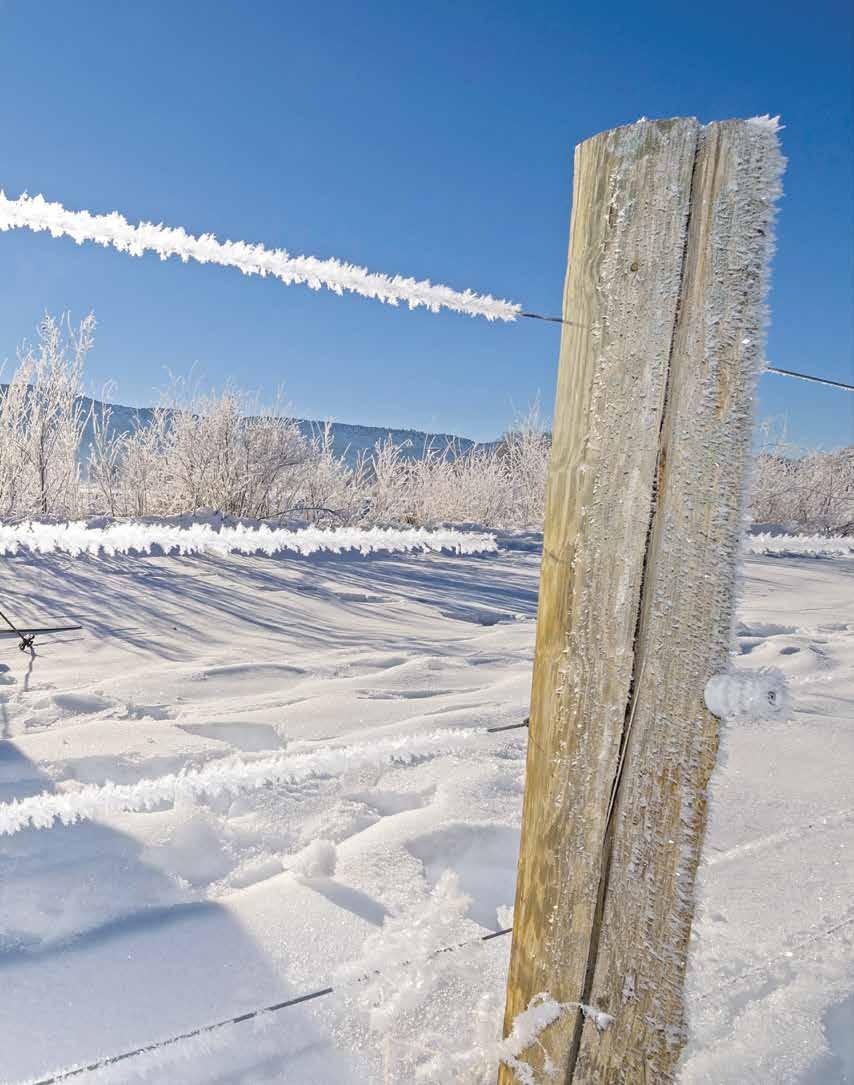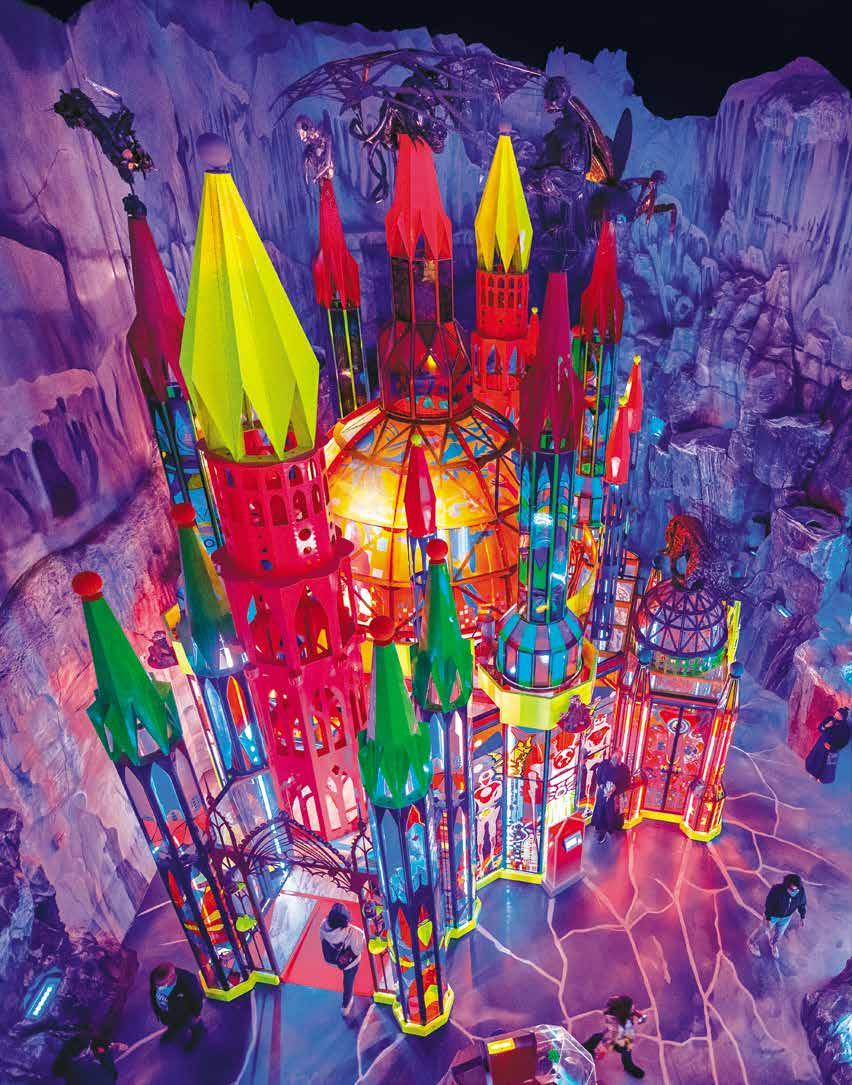
JANUARY/FEBRUARY 2022
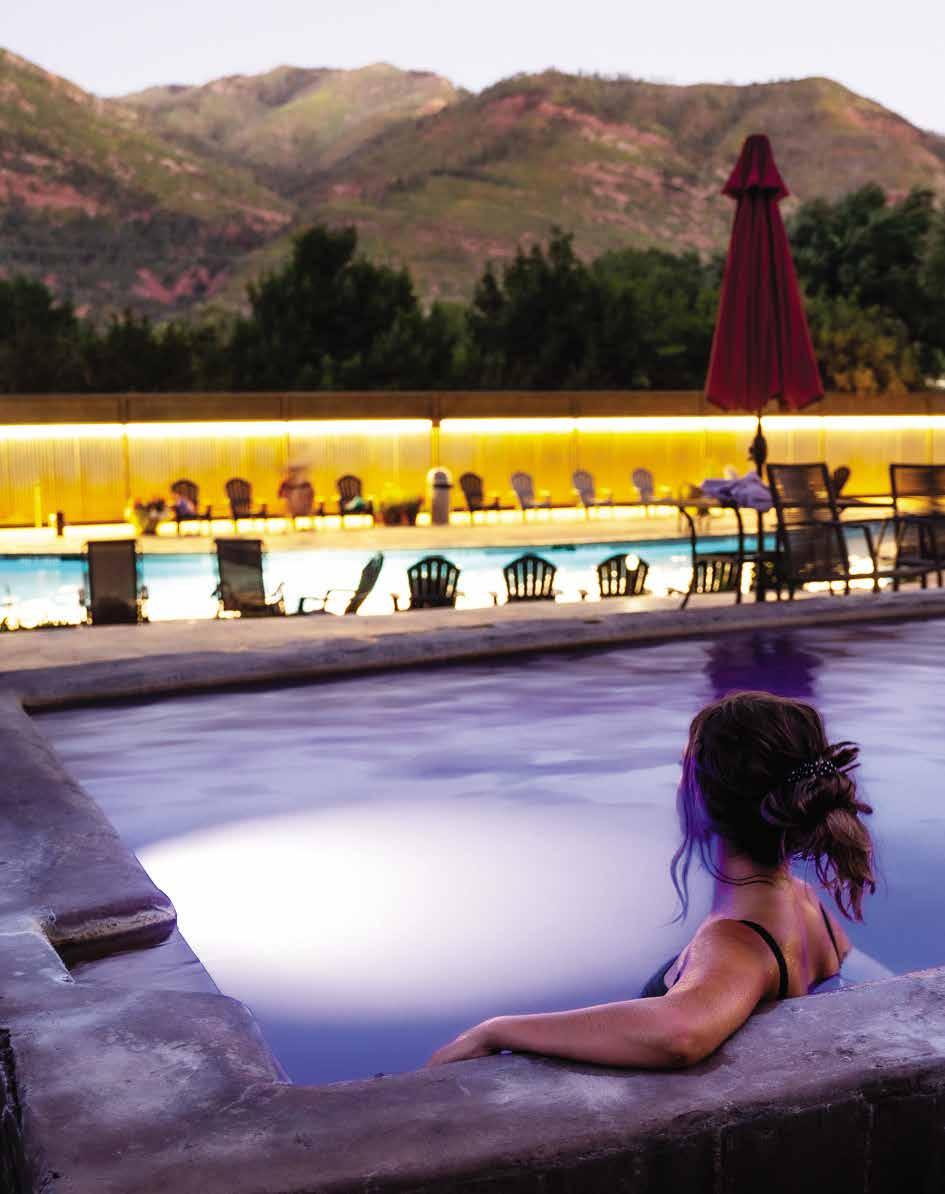


ISSUE NO. 59 JANUARY/FEBRUARY 2022
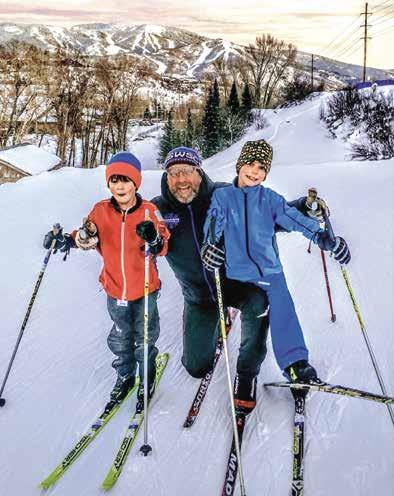


JANUARY/FEBRUARY 2022



ISSUE NO. 59 JANUARY/FEBRUARY 2022

Kids learn to ski at the Steamboat Springs Winter Sports Club, which has sent 95 of its alumni to the Olympics – more than any single town in the nation.
By Matt Masich
The melting pot of ethnicities that came together in Pueblo’s steel mills is responsible for the distinctive flavor combinations in the city’s unique sandwiches.
Story by Tom Hess
Photographs by Joshua Hardin
Dozens of Colorado artists spent four years working together to create a five-story interactive dream world that recently opened in downtown Denver.
Story by Leah M. Charney
Photographs by Joshua Hardin
Outside of Fort Collins, a team of fungus farmers uses tender care and scientific techniques to cultivate sought-after varieties of gourmet mushrooms.
Story by Lisa Truesdale
Photographs by Joshua Hardin





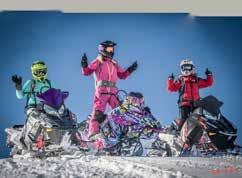
Steamboat Springs p 18, 55
Kremmling p 10

Fort Collins p 48
Estes Park p 57
Golden p 55
Silverthorne p 59
Breckenridge p 57
Crested Butte p 56
Ouray p 55

Aspen p 55
Greeley p 12
Fort Lupton p 12
Denver p 14, 44, 58
Evergreen p 11
Divide p 60
Lake George p 60
Lake City p 59
Pagosa
Springs p 57 Alamosa p 57
Durango p 57, 62
Pueblo p 24
Lamar p 54
Our poets celebrate mountain living with poems about Colorado’s spectacular peaks.
Go. See. Do.
Our statewide roundup of the best local festivals, events and daytrip ideas to check out for fun wintertime adventures all across Colorado.
To secure campsites for summer camping expeditions, winter is the time to make reservations.
Ice crystals on a wire fence make for a magical winter scene in our featured photo from Durango. 36




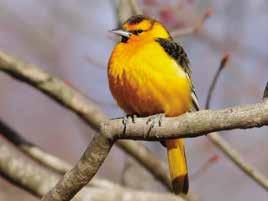


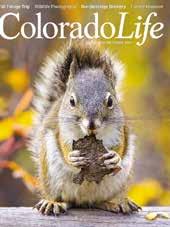


Volume 11, Number 1
Publisher & Executive Editor
Chris Amundson
Associate Publisher Angela Amundson
Editor Matt Masich
Photo Editor
Joshua Hardin
Design
Traci Laurie, Open Look Creative Team
Advertising Sales
Marilyn Koponen, Lauren Warring
Subscriptions
Lindsey Schaecher, Janice Sudbeck, Azelan Amundson, Teresa Eichenbrenner
Colorado Life Magazine
PO Box 430 • Timnath, CO 80547 (970) 480-0148 ColoradoLifeMag.com
SUBSCRIBE
Subscriptions are 1-yr (6 issues) for $24 or 2-yrs (12 issues) for $42. Please call, visit ColoradoLifeMag.com or return a subscription card from this issue. For fundraising and corporate rates, call or email subscriptions@coloradolifemag.com.
ADVERTISE
Advertising deadlines are three months prior to publication dates. For rates and position availability, please call or email advertising@coloradolifemag.com.
CONTRIBUTE
Send us your letters, stories, photos and story tips by writing to us, visiting ColoradoLifeMag.com or emailing editor@coloradolifemag.com.
COPYRIGHT
All text, photography and artwork are copyright 2021 by Flagship Publishing Inc. For reprint permission, please call or email publisher@coloradolifemag.com.

IBET YOU’VE PROBABLY noticed this by now, but there are kind of a lot of mountains in Colorado. Even in the parts of the state where the actual Rockies aren’t visible, you still see green-and-white versions of them everywhere you go on our license plates.
Considering how big a role the mountains play in Colorado life, it makes sense that they also play a big role in Colorado Life Magazine. The famously beautiful peaks of the Maroon Bells appeared on the cover of our very first issue nearly 10 years ago. Mountains also appeared on the next cover – and every cover after that for our first year and a half.
We’ve since branched out, with cover shots including images of the Plains, wildlife and a neat bird’s-eye-view photo of Denver’s Cash Register Building. But one thing has always remained the same: All of our cover images have depicted an outdoor scene. Until now.
The magazine you hold in your hands is the 59th issue Colorado Life has printed – and the first issue of Colorado Life to have a cover image depicting a scene happening completely indoors.
The multicolored castle on this issue’s cover is part of Meow Wolf Denver, a five-story interactive art experience that opened a few months ago in the Mile High City. You can read all about Meow Wolf and see even more astounding photos in our feature story on page 44.
When the Colorado Life editorial staff meets to decide what image to put on the cover, we usually have so many great options that narrowing it down to one can get pretty difficult. I didn’t have that problem with this issue – I knew we would never again have the chance to put something as crazy-looking as Meow Wolf on the cover, so I wasn’t going to let the opportunity pass us by.
At first, I was concerned about how our subscribers would react to such a departure from our typical covers. But the more I thought about it, the more certain I was we made the right move. Colorado Life has never been only about the mountains or the outdoors; it is about all of the people and places that play a part in Colorado’s life story. And because Colorado’s arts scene and cultural institutions are a huge part of that story, it’s probably long past time we put something like Meow Wolf on the cover.

I am proud of the work Colorado Life has done to explore the diversity of experiences available to us in Colorado. In 2021, we had stories on backcountry skiing, the Brown Palace, astronaut Jack Swigert, an Eastern Plains road trip, Breckenridge Brewery, camping in state parks and much more.
And I am excited about the stories we have in the works for 2022. Though I don’t want to give away any spoilers, I will say there’s a fairly good chance you’ll see a story or two about the mountains in the not-too-distant future. But given the wildly varying topography and colorful cast of characters found in Colorado, I think it’s also safe to say there will be plenty of surprises in store this year.
Matt Masich Editor
Bravo, Brown Palace
I would like to thank Leah M. Charney for writing and you for publishing the amazing article “The Brown Palace” in the November/December 2021 issue of Colorado Life. And I must also applaud the amazing photographs taken by Joshua Hardin.
Although I first encountered the Brown Palace in 1960, I did not enjoy the interior of this landmark until I started practicing law downtown in 1980. There are many iconic buildings still existing in downtown Denver, but none have the appeal and history of the Brown Palace.
The article rekindled many memories of high tea, champagne pours, livestock in the lobby, wonderful meals in all of the restaurants, and the amazing atrium. I very much enjoyed the history related in the article, artfully blended with the personal stories of the Brown Palace’s staff.
The Brown Palace has always had a rejuvenating effect upon me as I’ve walked downtown Denver for the past 40-plus years, and this article was almost as enjoyable as visiting the actual building. Thank you for reminding me that beauty and joy are always available at the intersection of 17th and Tremont.
Robert F. Rosenthal Denver
Palace is a good neighbor
I have worked across the street from the Brown Palace in two different buildings. I always loved the view. When I worked for a commercial real estate company at the front desk, the brokers would take me there for Admin Day, and one boss would take me there for tea and my review. The same company would host events in the conference rooms, and a Christmas party or two. My husband and I went once for brunch. We hosted about 300 language students over the years. They all got to have a view of the lobby, and often we would eat at the Ship Tavern.
Reading this article brought back so many memories. What touched my heart the most was the employees watching the door being locked for the first time. A great article.
Rita Sokolowski Denver

We look forward to the day Colorado Life appears in the mailbox. The photography is always a treat. I am a native Coloradan, having grown up in Estes Park, attended CSU, worked in Loveland and then retired back home to Estes with hubby Jim, who is a born flatlander but loves Colorado as I do. Surely there couldn’t be much we hadn’t seen – but how wrong we were.
The November/December 2021 issue convinced me that I have likely walked right past ptarmigan over and over again (“Finding Feather-footed Ghosts”). The same issue took me down memory lane to visiting the Brown Palace with my grandmother. But the best issue – judging by the sticky arrows adorning its pages – was May/June 2020. We used it to plan a trip to western Colorado (“Northwest Exposure,” May/June 2020) as a COVID escape from the house and again had to wonder how we had missed this part of our state. Beginning at Rifle Falls, we traveled on to Grand Mesa and spent a marvelous day driving and hiking Canyon Pintado. I can’t believe we never knew about this treasure of the Old Ones’ art pecked into rock all over western Colorado. We went home via the Flat Tops Wilderness, which we had known about but never visited. The fall colors were amazing – almost too much to absorb.
Thanks so much for the excellent writing and photography that encourages us to get out and explore this place we call home. We keep every issue so we can refer to them for more ideas and enjoy
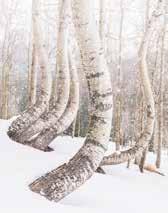
it so much that we are giving our adult children subscriptions for Christmas.
Carol Nussbaumer Estes Park
The article “Finding Feather-footed Ghosts” immediately immerses you on a journey in the snow-covered mountains of Colorado. You feel the peace and quiet of the powdery snow and envision the challenge of finding camouflaged ptarmigans. Aspects of the ecology are interwoven with admiration for Joyce Gellhorn’s skill and dedication to studying and promoting conservation of the ptarmigan.
Mary E. Anderson Tucson, Arizona
I just want to say how much I have enjoyed my gift subscription from a co-worker last December. I renewed my subscription, shared my copies with my mom and purchased a gift subscription for my in-laws.
Reading Colorado Life from cover to cover is delightful. The photos are amazing, and the articles are interesting and informative. My favorites in the November/ December 2021 issue were “Broadcasting from Boulder,” “Finding Feather-footed Ghosts” and “The Brown Palace.” I hope to continue to read your magazine for many more years.
Karen Price Broomfield
In Fremont’s footsteps
In the November/December 2021 issue, it was good to hear about John Fremont and the San Juan Mountains (“John C. Fremont’s Frozen Fourth Expedition”), as I was raised in the San Luis Valley. I always like the natural scenery pictures in Colorado Life, but I was also impressed with the information on the Brown Palace Hotel in Denver. I did not know too much about it – just its name. Now it has been explained in an informative way that the hotel history is much more meaningful.
Paul C. Witt Ripon, California
Painterly photography
I always enjoy receiving Colorado Life. Because I am an avid photographer, the first thing I do is scan the magazine for terrific photos. The November/December 2021 cover photo is terrific and has a painterly look. The magazine ends with a great capture of a dog sled race taking place on Grand Mesa (“Top Take,” November/ December 2021). To put the icing on the cake, both photographs were taken by an incredibly talented photographer friend, Angela Moyer, who lives in Montrose. Then I saw the bighorn sheep at Georgetown (“Go. See. Do.,” November/ December 2021) and the snow-covered Great Sand Dunes (“John C. Fremont’s Frozen Fourth Expedition”). These photos brought back memories the times I have photographed the bighorn sheep at Georgetown and hiked to the top of the Star Dune and Hidden Dune at the Great Sand Dunes. The articles were well done and highly informative. I cannot wait until my next issue of Colorado Life arrives.
Rod Martinez Grand Junction
Roxborough ranger remembers
Thank you for the article on Roxborough State Park in the November/December 2021 issue. I was a ranger there in 1998 and recall too much wildlife observing to count. Literally, just about every day I worked there I saw at least one black bear, and the bird count is off the charts.
There’s nothing like strolling through those trails while listening to a canyon wren echo down the canyon. On one day, I even saw three different foxes: two black-morphed red foxes and a gray fox. I hope Denverites truly appreciate this gem of nature right out their back door. And look out for lions while you are there –perfect habitat.
John Derinzy Burleson, Texas
‘The Bee’ truly is golden Having lived in Estes Park for 13 years, I have enjoyed every copy of Colorado Life magazine since its first publication. Every article is factual and delightful to read. My father was a professional photographer, so I especially enjoy the beautiful photos in every magazine. I do miss my friend Dick Orleans, who left us with stunning photos to remember him by. Colorado Life Magazine shared many of his photos.
Regarding your article on the Golden Bee pub (“Flight of the Bumblebee All in Good Fun at the Broadmoor,” November/ December 2021), I loved remembering our fun times there listening to the awesome piano music and catching my own golden bees, which still reside on my refrigerator. It truly is one of the special “nuggets” in Colorado.
Carol Smith Lincoln, Nebraska


Explore Colorado with the new 2022 Colorado Life wall calendar! It has the gorgeous photography you love in the magazine, ready to hang in your home or office.
Order before they’re gone!
SEND US YOUR LETTERS
We can’t wait to receive more correspondence from our readers! Send us your letters and emails by Jan. 15, 2021, to be published in the March/April 2022 issue. One lucky reader selected at random will receive a free 1-year subscription renewal. This issue’s winner is John Derinzy of Burleson, Texas. Email editor@coloradolifemag.com or write by mail to PO Box 430, Timnath, CO 80547. Thanks for reading and subscribing!

by ETHAN GANNETT
Driving through the gates of Latigo Ranch in the Rocky Mountains northwest of Kremmling, a vision from an entirely different mountain range appears: a herd of long-haired Himalayan yaks approaches, eager to greet visitors, hoping they may bear treats.
Latigo’s unusual livestock reflects the unique style of owners Randy and Lisa George, who have operated the historic dude ranch for more than 30 years. Though the ranch offers traditional Old West activities like horseback riding and cattle roundups, this is no ordinary dude ranch. In winter, the George family transforms Latigo into a cross-country ski area with spectacular views of the valley below. Randy personally “concierge grooms” the 50 kilometers of trails, laying fresh trail ahead of guests’ chosen destinations.
Raising yaks, bovine animals a little smaller than cattle, is an experiment Randy started in the slow pandemic summer of 2020 with his daughter and head wrangler, Hannah. Nine yaks, including two calves, arrived one day in early July. A little surprise came the next day, when little calf Liberty was born on the Fourth of July, increasing the herd to an even 10. Hannah devoted herself to calves Liberty, Effie and Tic-Tac. To wean them from their mothers, she lovingly made a mash of oats, alfalfa, and “cow cake” every morning to entice the babies to eat. After a few days, they would frolic to and fro, eagerly standing on snow banks to spot her coming with a bucket of treats. Slowly, they learned that human touch, petting their faces while they were eating, was tolerable. By the end of weaning, the young yaks would come up to her for pets and to

lick her hands.
The cycle continues, with three new baby yaks born last summer. The ranch crew tends the herd on foot, rather than horseback, to avoid working up the animals. The care the animals receive is up close and personal – except for the few months in the summer when an intimidating bull yak visits the herd. “Until he goes back home,” Lisa said, “we tend them from a distance.”
Yaks are a developing industry in Colorado, like bison, Randy said. Bred for
their tasty meat and fine, cashmere-soft hypoallergenic and hydrophobic wool for clothing, yaks are gentle on the surrounding vegetation despite weighing as much as 1,800 pounds.
With fine dining offered on the ranch, head chef Spencer George hopes to include ranch-raised yak on the menu later in 2022. But for now, Liberty and her yak buddies are content to serve their primary purpose of being furry friends to all who visit Latigo Ranch.
by TOM HESS
Evergreen Lake freezes into an ice skater’s paradise each winter. Locals in Evergreen say the 8.5-acre lake is the largest Zamboni-maintained outdoor ice rink in North America – or the world, depending on who’s telling the story. The folks at Guinness World Records have yet to confirm the claim, but after seeing the hundreds of people on the ice on a winter weekend, it’s not hard to believe.
Overseeing the skating action from the shore of Evergreen Lake is a bronze statue of the queen of Colorado ice skaters, Peggy Fleming.
Fleming was a 15-year-old student at Colorado Springs’ Cheyenne Mountain High School when she won the 1964 U.S. women’s figure skating national championship. In 1968, she won the gold medal at the Winter Olympics in Grenoble, France – becoming the only American to win gold that year. Those who watched her skate still vividly remember her poise, as well as her chartreuse outfit.
Few figure skaters have embodied artistic skating as much as Fleming. While she praises the “fantastic performances” of some modern skaters, she laments that skating today “is all about jumps” and demonstrations of pure athleticism.
Fleming is a standard bearer for a more graceful style of skating. At an annual competition at Colorado Springs’ Broadmoor World Arena, she presents the Peggy Fleming Trophy to skaters who exhibit the most artistry – not necessarily the ones who do the most complicated jumps.

A larger-than-life statue of Colorado figure skater Peggy Fleming stands at the edge of Evergreen Lake. Fleming won a gold medal at the 1968 Winter Olympics.
She personally selected Evergreen sculptor Harold Linke to sculpt the trophy, which debuted in 2018 to coincide with the 50th anniversary of her Olympic triumph. The Evergreen Lake statue is actually a supersized version of the trophy sculpture, commissioned by nonprofit arts group Sculpture Evergreen.
Fleming said the sculpture expresses the feeling of skating rather than her exact likeness.
“It pictures me in the middle of a performance, a fleeting moment, holding a position for a few seconds,” Fleming said. “It could be any of the artistic skaters, female or male.”
Sculptor Linke says the statue is “heroic
sized.” That much was apparent when Fleming attended the statue’s dedication in September 2020 – the 8-foot-tall sculpture on a 3-foot-tall granite pedestal towered over the 5-foot-3 ½-inch-tall figure skater.
Fleming lives in the Denver area with her husband, Greg Jenkins, whom she met while attending Colorado Springs’ Colorado College. She is a member of the U.S. Olympic Hall of Fame and recently helped publicize the new Olympic and Paralympic Museum in downtown Colorado Springs. It seems only fitting, as it was Fleming who put Colorado on the Olympic map in the first place.

by LISA TRUESDALE
A rifle with no bullets is no match against 140 agitated rattlesnakes, but Katherine McHale Slaughterback wasn’t one to back down. Desperate to protect her 3-year-old son, Ernie, outside their isolated farmhouse northeast of Fort Lupton, she tossed her empty weapon aside and snatched up the closest thing she could find: a wooden post with a metal “no hunting” sign. Whirling about frantically for more than two hours, she used the signpost to methodically bludgeon every single rattler to death.
News of such a feat travels quickly, especially when the snake slayer is a woman,
and the year is 1925.
Slaughterback, later nicknamed “Rattlesnake Kate,” returned to the scene the next day to retrieve the snakeskins as souvenirs. And here’s where her correspondence classes in taxidermy came in handy: She promptly sewed the skins onto a flapper-style dress that she wore proudly for the rest of her life.
Neyla Pekarek was a music student at the University of Northern Colorado when she first spied that curious rattlesnake dress displayed in its airtight, climate- and light-controlled case at the Greeley History Museum. Fascinated with Kate’s story – actually “obsessed,” she admits – Pekarek couldn’t get it out of her




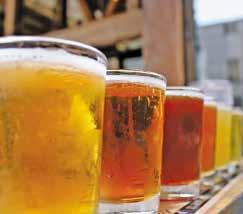


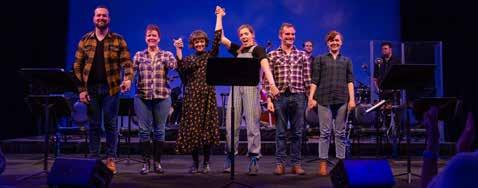
mind, even during her eight years of touring with the Grammy-nominated Denver folk-rock band the Lumineers.
In 2019, Pekarek launched her solo career with her first album, Rattlesnake. The songs on the album, like “Better Than Annie” and “The Perfect Gown,” are Pekarek’s contemporary retelling of the Kate story. Before it was even released, it caught the attention of the folks at the Denver Cen-

ter for Performing Arts. And how could it not, with Pekarek performing songs from the album while wearing her own rattlesnake-print dress?
The DCPA commissioned Pekarek and playwright Karen Hartman to create the musical Rattlesnake Kate based on the album and on Kate’s life story. Using the songs from her album as a framework, Pekarek composed new ones to fill in the

Nestled in the Estes Park valley, at the base of the Rocky Mountains, our custom studio has been crafting unique fine jewelry since 1976.
rest of the story. The finished musical, a highlight of the 2019 Colorado New Play Summit, was set to premiere in early 2021 – until the pandemic hit. After a year-long delay, it is now scheduled to open at the DCPA’s Wolf Theatre on Feb. 4, with three different actresses portraying Kate at different stages of her life.
Although Pekarek hasn’t been married six times like the unconventional, gun-toting, alleged bootlegger Kate, she feels a strong connection to Kate that she believes comes across in both the songs on the album and the music and lyrics she composed for the musical.
“We were both born and raised in Colorado,” she said. “We had options to leave here but chose to stay.” But it goes deeper than that: “Kate knew how to live authentically, even when it didn’t match what society expected. Her story inspired me to venture into my solo career, and I hope the play gives others the courage to live their most authentic life, too.”



WHAT’S INSIDE:
• 75 amazing hikes arranged from easiest to hardest
• Beautiful photos of every location
• Clear and easy-to-follow topographical maps
• Elevation profiles for each hike
LEARN ABOUT:
• Encountering wildlife
• Hiking at high elevation
• Rocky’s weather patterns
• Where to go
• What to pack
MAKES A GREAT GIFT!


by LISA TRUESDALE
The list of famous authors who have signed their books at Denver’s Tattered Cover Book Store over the years is as impressive as it is lengthy: J.K. Rowling, Julia Child, Ansel Adams, Maya Angelou and more. Their heartfelt inscriptions and signatures fill dozens of prized autograph books the staff keeps on hand.
Yet in Mark A. Barnhouse’s new book Tattered Cover Book Store: A Storied History, readers learn that much of longtime owner Joyce Meskis’ success can be attributed not to how she treated the many celebrities who visited, but that she always treated her employees and her customers like family. Oh, and she really loved books.
Writing a check, back when that was still a thing? No ID required – people are mostly honest, Meskis believed, and rarely did a check bounce. Want to hang out awhile? Make yourself at home in one of the many overstuffed armchairs. Looking for a particular book? The booksellers will walk you over to it and place it in your hands; they’ll never just point “over there.”
Barnhouse, a native Denverite, local historian and longtime fan of the store, reveres it as “a holy place, a church of ideas.” He traces the store’s legendary 50-year history, from its beginning in 1971, when it was teeny-tiny, through Meskis’ 40-plus years of ownership and expansion to multiple locations, to today, when Meskis has
retired and a new ownership group has taken the reins.

Barnhouse is also a former employee, so he’s able to impart a point of view that no other historian could.
“Whether you grew up in Denver or just arrived,” he writes, “chances are that you have a Tattered Cover story to tell.”
Tattered Cover Book Store: A Storied History
By Mark Barnhouse
The History Press
Paperback 160 pp, $22
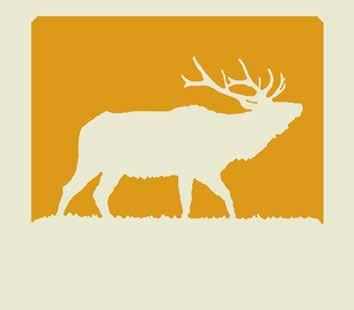
Award-winning documentaries and visitor information about Estes Park, Colorado and Rocky Mountain National Park. Start your free trial now!





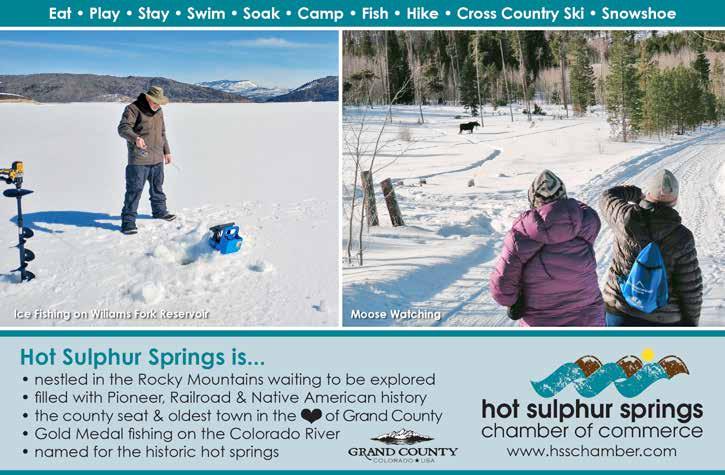




Test your knowledge of homegrown businesses. by BEN KITCHEN

1 Presumably a good place to pick up bread and milk, what convenience store franchise, currently headquartered in Pueblo, opened its first location in Fowler in 1973?





2 Appearing in many of their commercials throughout the years, what is the alliterative name of the founder of Englewood-based American Furniture Warehouse?
3 There are two completely unrelated companies based in Colorado called Spyder and Spyderco. Spyderco makes knives, while Spyder makes clothes for participants in what sport?
4 The Denver Nuggets’ home arena was called the Pepsi Center until 2020, when the naming rights went to what Broomfieldbased company?
5 What holey shoes, manufactured by another Broomfield-based company, are made of a trademarked resin called Croslite?
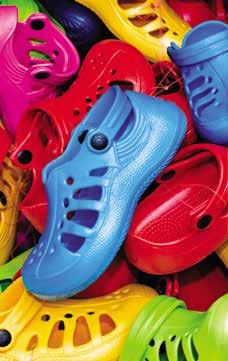
6
Noodles and Company, founded in Denver’s Cherry Creek neighborhood, has plenty of pasta dishes, but what is the only U.S. state whose name appears in one of the chain’s entrees?
a. Colorado
b. Wisconsin
c. Texas
7
Those who have seen the company’s logo would know that Greeley’s Pilgrim’s Pride specializes in the production of what kind of meat?
a. Beef
b. Chicken
c. Pork
8 Greenwood Village-based Newmont is the world’s largest company dedicated to mining what metal? The company mined nearly 5.9 million ounces of it in 2020, more than a million more than its closest competitor.
a. Gold
b. Silver
c. Copper
9 All three restaurant chains were founded in Colorado, but which of the following fastcasual spots is the only one still headquartered in the state?
a. Chipotle
b. Qdoba
c. Quiznos
10 As their name suggests, the company Rocky Mountain Metal Container makes metal containers, specifically for products made by what Colorado-based company?
a. Molson Coors Brewing Co.
b. OtterBox
c. Frontier Airlines

11
Colorado has more craft breweries per capita than any other state.
12
The name of Colorado-founded luggage company Samsonite is a reference to the biblical Samson.
13
Shortly after Boulder-based company PopSockets was established in 2012, it was sued because the name was too similar to that of microwave popcorn brand Pop Secret.
14
Founded in 1990, Breckenridge Brewery is still headquartered in Breckenridge.
15
Lakewood-based FirstBank’s first “branch” was housed in a 12-by-50-foot trailer known as the “Check Wagon.”
No peeking, answers on page 61.


EXPERIENCE the splendor of the Rockies at Aspen Winds. The secluded setting along Fall River, among the aspen and pines, offers a relaxing atmosphere. Aspen Winds is located minutes from Estes Park and Rocky Mountain National Park. We offer one and two bedroom suites and in-room spa suites. 970-586-6010 • 1-800-399-6010 1051 Fall River Court • Estes Park, CO
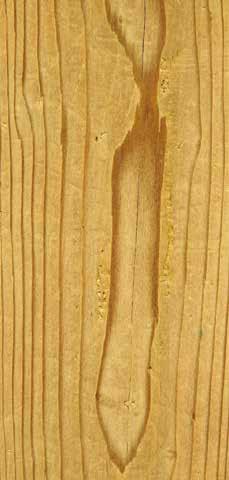

TASTE A DIVERSE selection of Colorado-grown wines at Snowy Peaks Winery
From sweet and decadent to dry and complex, we have something for every palette. Try our Coloradomade cheeses, meats and other tasty goodies, too! Two tasting flights for $10 with this ad.


by MATT MASICH
Steamboat Springs Winter Sports Club sends more athletes to the Olympics than some small countries
MEETING A WINTER Olympian in Steamboat Springs doesn’t take much effort. In fact, it would be difficult to live there for very long without rubbing elbows with an Olympic skier. The city has produced 98 Olympians – more than any other town in North America. Of those Olympians, 96 are alumni of the Steamboat Springs Winter Sports Club.
For more than 100 years, the club has trained local children in Nordic and alpine skiing at Howelsen Hill, the city-owned ski hill in downtown Steamboat Springs that includes a full-size ski jump. Roughly one-third of children in Steamboat Springs participate in the club’s programs.
“The Steamboat Springs Winter Sports Club is known for sending more Olympians than some small countries,” the club’s Rory Clow said.
The club sent 14 athletes to the 2018 Winter Olympics in Pyeongchang, South Korea. After Team USA’s 2022 Olympic roster is finalized in January, the club expects to send enough athletes to push its total number of Olympians above 100.
Carl Howelsen, the Norwegian skier who built the city’s first ski jump, inspired the creation of the club to develop athletes to participate in the first Steamboat Springs Winter Carnival in 1914. The annual festival, which features a skijoring competition and a night skiing show, is marking the 109th celebration of the Winter Carnival this year, Feb. 9-13. The event coincides with the 2022 Winter Olympics in Beijing, Feb. 4-20.
Colorado Life interviewed four Olympians who have trained, coached or both at the Steamboat Springs Winter Sports Club to find out what made it a success for a century and counting.


Jim “Moose” Barrows joined the Steamboat Springs Winter Sports Club at age 5 and has remained involved for the 70plus years since. Barrows competed in downhill skiing in the 1968 Winter Olympics in Grenoble, France, and coached the downhill team at the 1980 Winter Olympics in Lake Placid, New York.
WHEN I WENT to the Olympics in 1968, three of the eight members of our men’s alpine skiing team were kids from the Steamboat Springs Winter Sports Club.
In the ’50s and ’60s, the club didn’t have a management structure – just two or three people and a rope tow. Gordy Wren, who had been in the Olympics, ran it. At the time, there were only three alpine events. Now, you have 37 different events in the Olympics that take place on skis, and those are all now part of the Winter Sports Club.
I started the Moose’s Loose Golf Tournament as a fundraiser for the Winter Sports Club in 1975. We needed to have something to make sure kids in the Yampa Valley always have the chance to ski. The golf tournament benefits a scholarship fund we formed. We shoot to raise $20,000 to $25,000 each year.
The community revolves around skiing. It was a mechanism for a great lifestyle for me. Kids who live here should be able to at least try skiing. I just want to make sure kids have the same opportunities we did when I was growing up. I feel a responsibility toward the club. It has been part of the community for over 100 years – we have to continue cultivating it.


After training with the Winter Sports Club, Caroline Lalive competed in alpine skiing events at the 1998 Winter Olympics in Nagano, Japan, and 2002 Games in Salt Lake City. Her husband, Nelson Carmichael, is also an Olympic skier, competing in the 1988 Games in Calgary, Alberta, and 1992 Games in Albertville, France; his 1992 bronze medal in moguls made him Steamboat’s first Olympic medalist. Both have been coaches at the club.
MY FAMILY MOVED here when I was almost 16. I have two younger siblings, and we all were ski racers. My parents wanted to find a great spot for skiing and schools. I finished high school here and have been here ever since.
What is so unique about Steamboat is the community. In my mind, and for so many kids, the club is the heartbeat of the community. At Howelsen Hill, you’re surrounded by all the different sports, all the kids together. In all my travels around the world, there’s nowhere like it.
I knew from a young age I wanted to
Born and raised in Steamboat Springs, Johnny Spillane competed in the 2002, 2006 and 2010 Winter Olympics, taking home three Nordic combined silver medals at his final Winter Games in Vancouver, British Columbia. He now owns the local business Steamboat Flyfisher.
I WAS 7 or 8 when I started in the Winter Sports Club. I did a little bit of everything at first, but I pretty quickly gravitated toward the Nordic combined. I really liked the uniqueness of it; ski jumping and cross-country are so different from each other that it kept me interested the whole time.
The first time I went off the biggest jump at Howelsen Hill, I was 13 or 14. It’s nerve-racking when you go from one size jump to the next size up, but I didn’t have too many wipeouts. I had a few here and there on the World Cup circuit. In ski jumping, you don’t have many bad crashes

be an Olympian, but being in the club helped me realize it is attainable. It can be a bit of a Catch-22 for kids: Because there are so many Olympians, it can create a sense that it’s easier than it is. The club does a really good job of recognizing that, yes, competing in the Olympics is the ultimate dream for many kids, but also facilitating the experience for kids who aren’t going to the Olympics and just
want to have an awesome experience. Our 6-year-old daughter is in the Winter Sports Club. My son, who is 3, will start next year. If they show a certain talent or interest, I’d definitely want to foster that, but by no means are we pushing one way or the other. My hope is that they just love skiing. It has brought so much to our life, and we hope we can share it with them.
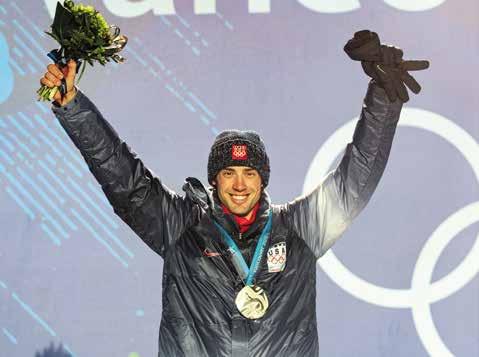

over the course of a career, but the ones you do have can set you back a bit.
There’s a such a unique culture at the Winter Sports Club and here in town. From what I’ve seen, it hasn’t been replicated anywhere in the world. To have all the disciplines training at one facility, with Steamboat’s history of having so many Olympians involved in the club, prepares you very well for the Olympics.
After school, everybody migrates down to Howelsen, whether it’s for figure skating or any of the skiing sports. It’s a big community family. I have three kids: My 11-year-old is a cross-country skier, and my 9-year-old is a figure skater. My 4-year-old doesn’t know up from down yet – but he’s a good skier.
Though he grew up in Winter Park, Todd Wilson began training on the Howelsen Hill ski jumps when he was 8. After competing in the Nordic combined at the 1988 and 1992 Winter Olympics, Wilson joined the staff of the Winter Sports Club, where he is director of the ski jumping/Nordic combined program.
WHEN I STARTED working here in 1992, there were 300 kids in the entire club. We’re just north of 1,000 kids this winter. Our ski jumping and Nordic combined program is the largest in the world.
The magic of the club is that you don’t have to be a rockstar athlete to take advantage of this culture. The longer I’m here, the more I realize the athletic part is the icing on the cake. We use youth athletics as a vehicle to teaching life lessons. We are just as proud of the kids who go on to start their own businesses as we are of the kids who make it to the Olympics. It turns out that becoming an Olympian, or just becoming successful in anything you choose to do, comes from the same foundation of life skills.
In sport and in life, you get out what you put into it – and what you get may not be what your goal was. I had a goal of being an Olympic medalist. I didn’t

Chris Rhodes
Todd Wilson trains the next generation of Steamboat Springs athletes as director of the Winter Sports Club’s ski jumping/ Nordic combined program.
quite reach that goal, but in that pursuit, I learned an awful lot about myself and the grit of falling on your face and getting back up.
That’s one of the best lessons we teach our kids. When people fail for the first time, they’re devastated, and they often don’t want to do it anymore. But you can’t succeed without failure. Is it easy? No. But we all have to pick ourselves up. When life is hardest, that’s when I think we grow the most.






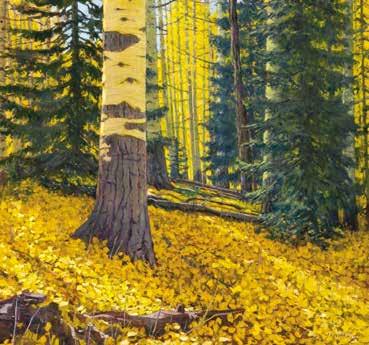
story by TOM HESS photographs by JOSHUA HARDIN
STEELWORKERS IN PUEBLO spoke 42 languages in 1916, earning the city a reputation as the Melting Pot of the West. A century later, that mixing of ethnicities and flavor traditions has given Pueblo a culinary character all its own. Nowhere is that more evident than in its sandwiches.
While most towns are happy to have even one signature sandwich, such as Philadelphia’s cheesesteak or New Orleans’ po’ boy, Pueblo has at least four sandwiches that are unique to the city: the Dutch Lunch, Pass Key Special, Slopper and Bingo Burger.
To eat any of these sandwiches is to experience Pueblo’s history and culture in edible form. Just as citizens from many backgrounds mixed, the city’s cuisine combines Italian, Hispanic and Slavic influences. And the star of local agriculture, the Pueblo green chile, figures prominently in many of these dishes.


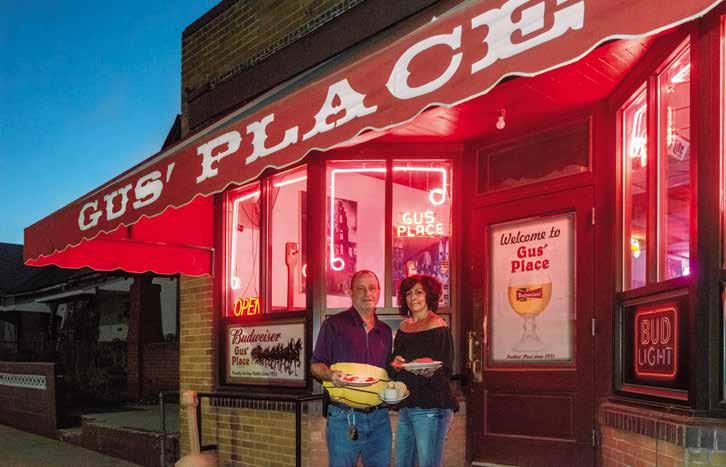
Gus’ Place
1201 Elm St.
The Dutch Lunch at Gus’ Place is not a sandwich until customers make it one.
The waitstaff delivers a tray of Italian-style meats and cheeses, accompanied by slices of soft bread, along with peppers, sliced tomato and condiments; customers then put it all together any way they want.
The build-your-own sandwich platter was created to feed steelworkers from the old Colorado Fuel & Iron steel mill, whose west gate was located just a few steps away from Gus’ Place when the tavern opened in 1934. In the mill’s heyday, workers packed Gus’ after quitting time for a Dutch Lunch and cold beer. In fact, the men from the mill were so thirsty that in the 1940s, Ripley’s Believe It or Not recognized the tavern as selling more beer per square foot than any other bar in the world.
Pueblo native and firefighter J.C. Reigenborn has been coming to Gus’ for Dutch Lunch since he was a teenager. As a youth, he wondered why his parents would pay
to assemble sandwiches they could build at home. Reigenborn quickly learned the answer: People come not just for the Dutch Lunch, but also to meet other people.
Patrons walking into Gus’ are often greeted by name, and strangers seldom remain so for long. On a recent weekday afternoon, two men sitting at the bar with “schooners” of ice-cold beer immediately welcomed a first-timer, asked his name and invited him over to join in their conversation.
Despite the Dutch Lunch’s name, its ingredients are Italian, as were the tavern’s original owner, Gus Masciotra, and most of the early steelworker customers. However, a sizable portion of the clientele were Slovenian steelworkers known as “Bojons,” which means “beautiful people” in their native language. And it was Bojons who came up with the idea for the Dutch Lunch, said Ben Gradishar, the Bojon who recently sold Gus’ Place to its current owners, Andy and Mona Klein.
Gradishar has been coming to Gus’ for as long as he can remember. His father, William, a steelworker union president
nicknamed “Snuffy,” started taking him to Gus’ when he was 5 years old. “Dad would tell Mom that he had taken me to the park,” Gradishar said, “but I ate red pistachios from a vending machine at Gus’, and my hands were red from the pistachios. Mom knew we hadn’t gone to the park.”
Some things have changed at Gus’ over the years. The walls have a fresh coat of paint, covering nicotine stains from decades of cigarette smoke in the now-smokefree bar, and the linoleum worn by generations of steelworkers has been replaced. But

the Dutch Lunch remains the star of Gus’ menu, keeping alive one of the tastiest parts of Pueblo’s steel-working legacy.
Pass Key Restaurant 518 E. Abriendo Ave.
The Pass Key Special is a long-running Pueblo tradition, as customers standing in line for a table will attest. Many locals have developed their own preferred methods of eating the sandwich, which features a seasoned Italian sausage patty, topped with shredded lettuce and mustard on a silky bun from family-owned Banquet Schusters Bakery, just down the street on Abriendo Avenue in historic downtown Pueblo.
Some people will chomp into the Pass Key Special, then take a bite of banana wax pepper, two of which arrive with the sandwich in a wax-paper lined basket. Others prefer to order the sandwich with a strip of roasted Pueblo chile already on it – a delicious mix of Pueblo’s Italian and Hispanic heritage.
Brothers Frank and John Pagano invented the sandwich in 1952, the same year they opened Pass Key Restaurant, whose name is an anglicized version of the Italian name Pasqui. The current Abriendo location opened in 1969 and retains the charm of a mid-century diner, with decor that includes a collection of antique keys above the cashier. Pagano family descendants and relatives now operate four Pass Key locations in Pueblo.
The Abriendo staff blends sausage from Frank’s Meat Market in Pueblo with a carefully guarded recipe of Italian seasonings on Tuesdays and Thursdays at the Pass Key kitchen. Longtime customers always know when the sausage patties are freshest.
Pass Key regular Leanna Wallerstedt of Pueblo, who has been ordering the Pass Key Special since 1975, recently stopped by to get a sandwich with her daughter Lisa Meter, who has been a fan of the Special for almost as long. They know of other lunch places that serve similar sandwiches, but they say none are as good as the Pass Key Special. And they both vouched for the banana wax peppers, which they say should never be wasted.


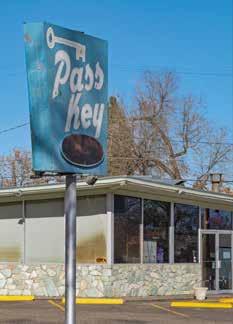
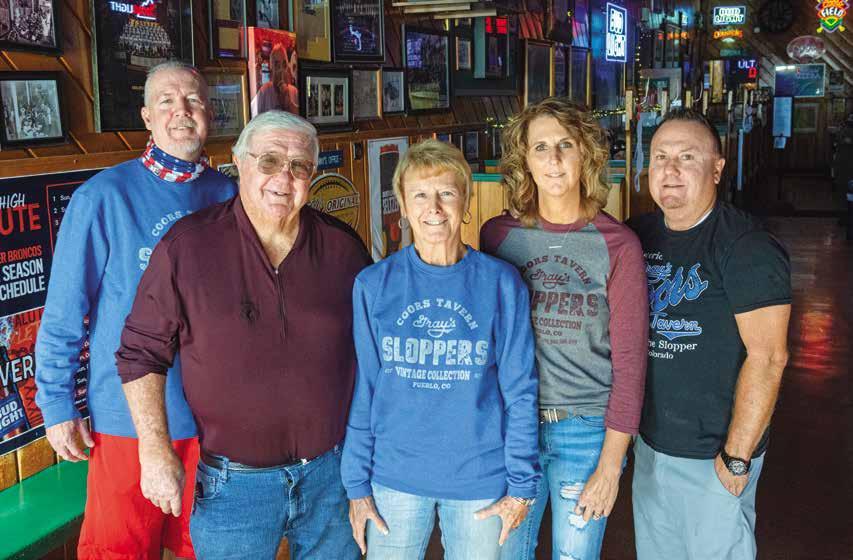
Gray’s Coors Tavern 515 W. Fourth St.
A handwritten sign inside Gray’s Coors Tavern informs all who enter that the restaurant’s green chile is “hot!” The exclamation-laden note serves as fair warning to patrons who have yet to experience the historic tavern’s signature sandwich: the Slopper, an open-faced hamburger with two beef patties smothered with green chile, fiery as promised, and chopped white onions.
Many people consider the Slopper to be Pueblo’s culinary claim to fame. The dish can be found on menus across Pueblo, but Gray’s Coors Tavern is where it originated. The restaurant’s odd name dates back to the end of Prohibition, when the Coors Brewing Co. sought to re-establish

itself in the local market. Coors partnered with an Italian, Johnnie Greco, in creating Johnnie’s Coors Tavern. Greco later sold the tavern to the Gray family, who have run it ever since.
The Slopper was born around 1950, owner Dean Gray said. It was the brainchild of a regular named Herb Casebeer, who would order a regular burger but tell the cook to “slop it up” with some of the eatery’s red chili con carne. Eventually, as green chile made from locally grown Pueblo chiles gained popularity, green replaced red as the standard Slopper topper.
Though the Slopper is a substantial meal by any metric, Gray’s Coors Tavern also offers a Double Slopper with four beef patties, and a Triple Slopper with six patties. Some choose to eat the dish with fries placed on top. It should go without saying that a sandwich as sloppy as the Slopper is eaten with a fork and not picked up with bare hands.
The tavern is a mile east of 15,000seat Earl “Dutch” Clark Stadium, Colorado’s largest high school football stadium. Teams and their fans fill Gray’s after games. Above the bar are helmets of Pueblo’s rival high school teams.
Just as patrons debate which football team is the best, there is a full-contact rivalry among Pueblo restaurants over who serves the best Slopper in town. The Star Bar has its own long history of serving the sandwich, and the Sunset Inn has been a popular Slopper stop for decades. But while Puebloans are happy to eat Sloppers wherever they may find them, for many, there’s simply no substitute for the original at Gray’s Coors Tavern.

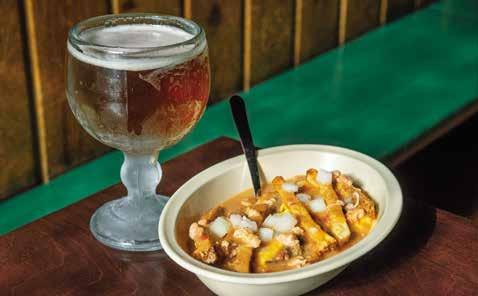
While most of Pueblo’s iconic sandwiches have been favorites for generations, the city’s craft breweries are putting new traditions on tap.
Walter Brewing Co.
126 Oneida St.
For most of the 20th century, Walter’s Beer was Pueblo’s drink of choice, helping bring together steelworkers of many nationalities for post-shift beers. The original Walter Brewing Co. opened in 1898 and, save for a hiatus during Prohibition, brewed its signature lager until the brewery closed in 1975. In 2014, a group of Puebloans relaunched Walter’s as a craft brewery and taproom. The new brewery uses the Walter family’s original, pre-Prohibition lager recipe, while also introducing new beers made with local ingredients, such as Pueblo Chile Lager and Red Chile Lime.
Shamrock Brewing Co.
108 W. Third St.
Pueblo’s current longest-running brewery is Shamrock Brewing Co. The Irish pub opened in 1940 as the Shamrock Cafe. The addition of a small craft brewery in 2005 made the Shamrock the city’s first brewpub. Many of the brewery’s beers have an Irish theme, but there is also plenty of Pueblo pride on the tap list. A golden ale called Steel City Gold is one of the Shamrock’s best-selling brews, while the Pueblo American Pale Ale, or PAPA, puts a local twist on the popular pale ale style.
Brues Alehouse Brewing Co.
120 Riverwalk Place
Prominently located along the Historic Arkansas Riverwalk of Pueblo is Brues Alehouse, the most recent addition to the city’s craft brewing scene. Besides brewing and serving German-inspired beers, the large alehouse is one of Pueblo’s most popular events and live music venues. Many of Brues’ brews are aged in former whiskey or wine barrels; at any given moment, there may be 30 or more barrels of beer aging in the alehouse’s cellar.

Bingo Burger
101 Central Plaza
Bingo Burger hamburgers bring the heat: spicy candied bacon, sriracha ketchup, zesty dijonnaise and lots of Pueblo green chiles. Customers get a choice of beef when they order burgers: regular hamburger meat, or “Bingo beef,” which comes with green chiles mixed directly into the patty. Most folks choose Bingo beef – no surprise in a town as devoted to its chiles as Pueblo.
Before Bingo Burger existed as a restaurant, founder Richard Warner sold hundreds of his chile-blended burgers at Pueblo’s annual Chile and Frijoles Festival. Warner and his wife, Mary Oreskovich, followed that success by opening a brick-and-mortar shop in 2010 at the site of a former corner gas station.
Bingo names its burgers in honor of Pueblo’s steel heritage – among them the

Steel City, the Blast Furnace, the Boiler Maker and the Bessemer, named after a Pueblo neighborhood that was itself named after a steel-making process.
The restaurant’s hyperlocal focus includes the food itself. Bingo sources its ingredients from Pueblo businesses: beef
from Martino’s Cattle Co., cheese from Springside Artisan, buns from Harvest Moon Baking and chiles from Peppers & Pedals.
To bite into a Bingo Burger, or any of the city’s homegrown sandwiches, is to taste the true flavor of Pueblo.




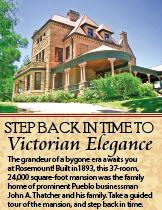
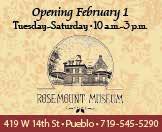

recipes and photographs by DANELLE McCOLLUM
WHILE THE WONDERS of modern transportation do much to bring the taste of fresh seafood to Colorado, no airlifted fish can match the freshness of trout caught right here in the lakes and streams of Colorado. Our recipes include a simple, quick and easy pan-fried trout, as well as tasty trout versions of salmon dip and crab cakes.
Whether camping in the great outdoors or in need of a quick weeknight meal at home, this simple but flavorful cast-iron-cooked trout, dredged in flour and spices, is ready in about 10 minutes.
Sprinkle trout fillets with salt and pepper, paprika and garlic powder. Place flour in shallow dish; dredge fillets in flour. Shake off any excess, retaining a thin coating of flour.
Heat butter and oil in large cast-iron skillet over medium-high heat. Add trout fillets, starting with skin side down, and cook for about 3 minutes per side, until trout is golden brown. Serve with fresh lemon wedges, for garnish.
1 ½ lbs trout fillets
Salt and pepper, to taste
1/2 tsp paprika
1/4 tsp garlic powder
1/2 cup flour
1 Tbsp butter
1 Tbsp olive oil
Lemon wedges, for serving
Serves 4

With a crispy outside and a tender, flaky inside, these trout cakes are a great way to use leftover trout. Fresh herbs and spices combine with breadcrumbs to make these trout cakes flavorful and delicious. They work equally well as a main dish or an appetizer.
In medium bowl, mix all ingredients, except vegetable oil, until well combined. Using hands, shape mixture into 4-6 patties, 1/2- to 3/4-inch thick. Refrigerate patties at least 20 minutes.
Heat vegetable oil in large cast-iron skillet over medium-high heat. Add trout cakes and cook for 3-5 minutes per side, or until dark golden brown. Serve warm with lemon wedges or a favorite dipping sauce.
1/2 lb trout, broken into small pieces
2/3 cup seasoned dry breadcrumbs
1 egg
1 tsp Dijon mustard
1 Tbsp mayonnaise
1 tsp Worcestershire sauce
2 Tbsp chopped chives
1 Tbsp chopped fresh parsley
1/2 tsp salt
1/4 tsp pepper
1/2 tsp paprika
Vegetable oil, for frying
Lemon wedges, for serving
Serves 4
Smoked trout is the star of this easy but elegant appetizer. Featuring capers, celery, garlic and fresh herbs, this dip is perfect served with crackers or sliced baguettes and is sure to impress at dinner parties.
Place all ingredients in medium bowl and mix until well combined. Refrigerate until serving. Garnish with additional chopped chives, if desired. Serve with crackers or sliced baguettes.
8 oz cream cheese, softened
8 oz smoked trout fillets, broken into pieces
1 Tbsp capers
1 clove garlic, minced
1/3 cup finely diced celery
1/4 cup mayonnaise
1 Tbsp chopped fresh parsley
1 Tbsp chopped fresh chives
1/2 tsp paprika
Zest and juice of 1 small lemon
Salt and pepper, to taste
Crackers or baguette slices, for serving
Serves 6-8

The editors are interested in featuring your favorite family recipes. Send your recipes (and memories inspired by your recipes) to editor@coloradolifemag. com or mail to Colorado Life, PO Box 430, Timnath, CO 80547.


The Rocky Mountains take on a new kind of splendor beneath a blanket of white. Our poets explore Colorado’s peaks with poems celebrating the mountains in their winter form, or reflecting on their ongoing presence in our lives in all seasons.
Summer Job at the Y, Estes Park: 1970
Melinda M. Rice, Parachute
Swing shift. We thought it was a bummer of an assignment till our perceived bad luck revealed itself as treasure: Gem Lake, Dream Lake, The Loch –hikes in the morning, back in the kitchen by afternoon, doing meal prep when the lightning struck.
We worked toward our goal in increments, a thousand feet at a time, climbing Flattop, Hallett, Audubon on our days off, our ETD, 2:00 a.m. at the trailhead some day in August.
Cher L. Tom, Palisade
White-capped crags strut Like majestic dancers Reaching rock fingers To the skies.
Twelve, thirteen, fourteeners, Blend teams together Chained by the sheer splendor Of the peak’s dizzying heights.
Mountaineers breathe in glory As Torrey’s summit lures; And opens a panoramic heaven.
We’d all read Isabela’s description of being hauled up from the Boulder Field by Rocky Mountain Jim and figured if she could do it in long skirts and leather soles we’d make it without much problem.
I think we crossed the Boulder Field at dawn. The hikemaster, most attentive to his own image, stood right on the edge at Chasm View. I lay on my belly looking down. Sun gleamed off the Diamond.
We became strung out while climbing the cables and above that I found myself alone, not quite sure which way to go.
A faulty handhold cautioned me to focus, take my time, choose my next moves carefully for the last pitch, the final facet.
The jewel: Long’s Peak.

Willadee Hitchcock, Golden
Land of my birth, ’neath the towering peaks
Magnificent fortress before mine eyes I see
Quiet whispers to my heart dost thou speak
Thy majestic splendor beckons me to thee
Dreams of wildflower meadows with icy founts
Pristine waters meander past evergreen pines
Stars shimmer between spiring, lofty mounts
Communing with the elk and the mountain lions
Betwixt and between, this interval life
Some need to inhale the salty mist of the sea
This soul yearns for a land with mountains rife
To revel in their grandeur and majesty
Ascent to life’s summit breached at long last
Lungs gasp for their concluding breath
Heavenbound, all grief abandoned to the past
From whence I came, to now return in death
Pray, inter me beside lovely rippled rills
In the shadow of thy resplendent hills
DO YOU WRITE poems about Colorado? We’re looking for poems about “Blossoming” for May/June, deadline March 1, and “Wilderness” for July/ August, deadline May 1. Send your poems, including your mailing address, to poetry@coloradolifemag.com or to Colorado Life, PO Box 430, Timnath, CO 80547.
Shirley Kobar, Loveland
in early afternoon
a billow of gray white sails surge across sky and envelop blue.
Wind whispers tickles plants it’s June. Whips off rose petals and leaves over Mt. Meeker in early afternoon.
Fly snapdragon seeds. Roils and brews snakes out lightning thunder deceives surge across sky and envelop blue.
Rumbles picnic today inopportune Become Mary Poppins or not over Mt. Meeker in early afternoon.
Canvas sags with a riffle too soon virga sheds shafts of rain surge across sky and envelop blue.
On striped umbrella festooned dampened hopes of moisture again over Mt. Meeker in early afternoon surge across sky and envelop blue.
Vaughn Neeld, Cañon City
where tundra spreads, alpine flowers fling petals wide to catch the radiant sun;
where clouds shadow-dance o’er rocky fells and glaciered dells trill with melting snow;
where enchanted lakes lie crystal clear in sheltered vales and fling their glee above;
where we snatch deep breaths of rarified air as wonder dazzles our dizzied sight;
where the sky, immense, intense bears down to snatch each breath;
where at the peak, we exalt in awe of the grandeur, stunned by the glory.
Dozens of Colorado artists collaborate to create a five-story interactive dream world in Denver
story by LEAH M. CHARNEY photographs by JOSHUA HARDIN
AT FIRST GLANCE, there seems to be a spaceship docked in the middle of Denver between Interstate 25 and Colfax Avenue. Closer inspection reveals the strange object is actually the oddly triangular, five-story building that houses the new, interactive art-meets-entertainment adventure of Convergence Station, also known as Meow Wolf Denver.
As otherworldly as Meow Wolf Denver looks from the outside, it only serves as prelude to the chaotic interdimensional space travel awaiting all who step inside.
Space travel? Indeed.
It is obvious this will be different from a standard museum experience from the moment visitors arrive. The first person guests meet is someone clad in a spacesuit, who calls out through an amplified headset, “Welcome to Convergence Station. Have you traveled with QDOT before?” QDOT, we learn, is the Quantum Department of Transportation, the agency tasked with guiding “travelers” through this strange spot.
Though it is billed as an immersive storytelling experience, Meow Wolf Denver often feels like a sci-fi amusement park. The astronaut greeter is one of many “creative operators” stationed throughout. Each of these employees portrays a character, lending verisimilitude to the universe that visitors discover, room by room.
If visitors are confused or overwhelmed, that’s OK: Guests are encouraged to lean into “what the heck is going on?” feelings and explore the worlds – plural.
MORE THAN 110 Colorado artists were part of the massive team that spent four years creating Convergence Station. It is the third and by far largest Meow Wolf location. When the artist collective originally started in Santa Fe in 2008, the name Meow Wolf was chosen at the collective’s first meeting; members filled a hat with words written on scraps of paper, then drew two words at random.


A glowing, multicolored castle is part of the ice world of Eemia at Meow Wolf Denver’s Convergence Station. The premise of the art experience is that a freak cosmic event tore loose pieces of four separate universes, which then merged with each other to form Convergence Station.
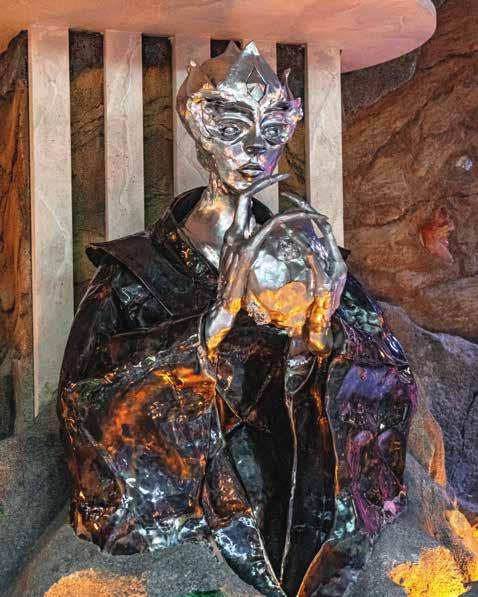
According to Convergence Station’s storyline, the people of the world of Ossuary are librarians who preserve knowledge in special stones. Visitors can explore Ossuary’s unusual library.
There are layers to the Meow Wolf Denver experience. The overarching narrative concept is that 25 years ago, a cosmic aberration opened a portal between four different worlds: Convergence Street, Eemia, Ossuary and Numina. The collision of these worlds made parts of them merge, erased citizens’ memories and caused the disappearance of four women.
Convergence Street, or C Street, was the sanitation district on its home planet but, set free by the cosmos, the residents of this Blade Runner-esque world now enthusiastically collect and trade memories and vote for a new mayor every 20 minutes. The tiny ice world of Eemia is steeped in an ancient order known as the Kaleidogoths. The people of Ossuary are librarians, attempting to store and preserve knowledge in special stones.
Numina, the largest world, is actually a living being that exists in six dimensions. The creative operators here portray quiet researchers; they won’t speak unless spoken to, but when asked, they theorize that Numina is keeping all the other worlds from disintegrating into primordial soup.
Visitors who can’t fully digest the complex storyline will still understand that nostalgia connects all the parts of Convergence Station. C Street evokes the 1980s as much as it does the future, with its Pizza Pals Playzone having the feel of an alternate reality Chuck E. Cheese. Parts of Numina are reminiscent of the Rainforest Cafe chain popular in the 1990s. Even the imagined currency is known as “mems,” short for memories.

MEMORIES ARE AT the heart of “Ruptured Time,” an installation within the world of Ossuary that immediately feels like stepping into a brain-themed living room. The space, created by Denverbased artist collective the Church of Many, is a marriage of art and craft, and each artist’s personal story.
Most of the collective’s members met while studying design at Metro State University, and all five had a personal connection to a loved one who dealt with dementia. But the installation’s concept – a space showcasing the brain simultaneously creating and losing memories – was directly inspired by experiences Andrea Thurber had with her grandmother, who was herself an artist.
The creation was a family affair the whole way through. It was Thurber’s sister who saw the news that Meow Wolf was seeking proposals from local artists and encouraged Thurber to apply. Another collaborator’s sister helped finesse the proposal so it stood out among the thou-
sand or more applications.
Thurber’s mother and aunt helped sew and assemble pieces affixed to the couch, walls and even ceiling of the space. At one point, huge sections of the display’s 30,000 strips of fabric, 1,500 CD pieces and 240 feet of aluminum dryer ducting were under construction at her family’s ranch near Sedalia.
Screens in gilded frames flash images and disrupted video clips from 45 home movies from the artists’ childhoods. Some of their voices are also included in the room’s audio, which adds an aural element to the synapses twinkling throughout. Aside from the mix of mediums, it was a creative challenge on multiple levels. Every item had to be approved by the fire department and designed to withstand an anticipated 1 million visitors.
LABORATION of Colorado artists at Meow Wolf Denver is called “Indigenous Futures Dreamspace Lounge.” The
installation features benches to encourage visitors to relax and reflect on the 360-degree mural, symbolic video and 90-minute looped soundtrack.
When multidisciplinary artist Adrian H. Molina heard the excitement surrounding “this thing called Meow Wolf,” he knew he wanted to apply. A poet and rapper performing under the name Molina Speaks, he also curates visual and performance artists, including a successful 2019 collaboration with the Denver Art Museum. As he thought about multiple project ideas, one artist kept coming to mind: Stevon Lucero.
Lucero, a co-founder of the Chicano Humanities Arts Council, was a legendary painter and key part of the city’s art scene for the past 50 years. Molina knew Lucero’s skills and guidance could produce a fruitful collaboration. What he didn’t know was that Lucero already had a vision for their project – a vision he had been nurturing for more than four decades.
A vivid dream had haunted Lucero
Andrea Thurber sits in the installation “Ruptured Time,” which she and fellow members of Denver-based artist collective the Church of Many created in Ossuary. The installation draws on the artists’ personal stories to explore themes of memory.


The largest world to discover at Convergence Station is Numina, which is said to be a sentient being that exists in six dimensions.


The trash and old street signs used to construct Convergence Station’s “Gremlin Symphony” installation were salvaged from various places across Colorado.
since 1975, but he had never been able to realize it in painting form. Combining the storytelling capacities of music and paint – plus video totems representing the five epochs of the Aztec calendar – enticed Lucero to effectively come out of retirement to work on the project and take Molina on as an apprentice.
The result is a visual story that takes place spread across a zigzagged, sixwalled room, incorporating elements of Toltec, Aztec and Chicano folklore. Ten storytellers, including Molina and Lucero, are featured in the audio accompaniment. All told, the artists incorporated into the project range from 22 to 71 years old.
The installation also acts as a love letter to the art and life of Lucero, who died in November. Lucero’s work and tutelage impacted several generations of Chicano and Latino artists across the Southwest. Molina is especially excited that Lucero’s work is finding an audience outside of a museum or gallery because of Meow Wolf’s wider appeal. Not only does Convergence Station bring different kinds of art into the mainstream, but it encourages people to experience it in entirely new ways.
to have something for everyone – and comes remarkably close to succeeding. Art lovers can gawk at the level of skill on display. Video gamers can nerd out on interactive games, including a laser light show on Eemia’s ceiling. True crime obsessives can solve the mystery of what happened to the four women who went missing at the moment of convergence.
Side mysteries also appear in singular hallways, never to be referenced anywhere else. Many tunnels and secret doors have been placed at child height, though all are encouraged to tap into the inquisitive child within. The large elevators and stairwells provide quiet corners for the overstimulated, plus easy entry to varying parts of the building.
The installations are 90 percent wheelchair accessible and designed to be enjoyed by users of all ages, backgrounds and abilities. Seats are placed throughout to give visitors chances to rest while roving the 65,000 square feet of exhibition space.


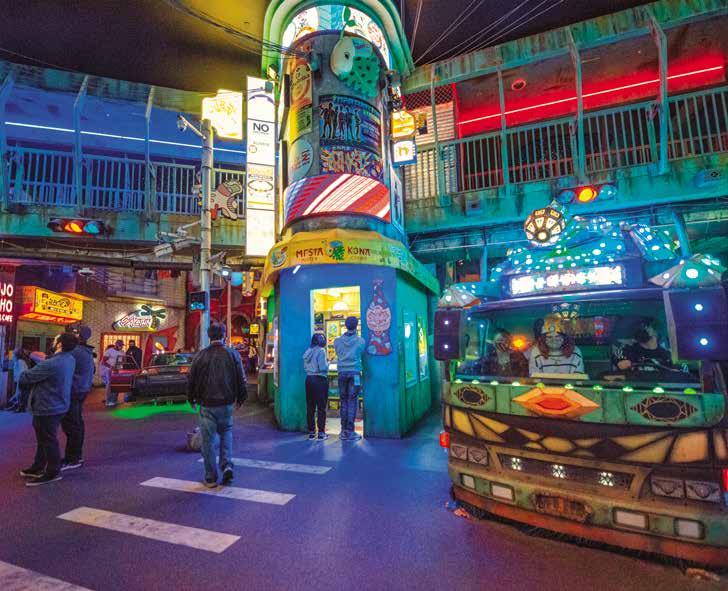
Because so many Colorado artists worked with the Meow Wolf team to bring their unique projects to life, the result is a space that feels simultaneously not of this world and close to home.
“Melting of Mines” is a surrealist landscape created using images of real Colorado mines. “Prairie Dog Fever Dream” invites visitors to see the flora and fauna of the Eastern Plains from a rodent’s perspective. The “Gremlin Symphony” room includes street signs from so many Colorado municipalities that it’s a fun game to
see how many street names or sign types longtime residents can spot from Greenwood Village, Grand County and beyond.
Other easter eggs have been placed in the form of replicated signs from places of Denver past, like CinderAlley from bygone shopping mall Cinderella City, and the beloved Denver Drumstick, where fried chicken came in a boxcar and a train went room to room around the entire restaurant.
As visitors stumble out into the parking lot, processing what they’ve seen over the
past several hours, the voice of a QDOT employee echoes behind: “Thank you for traveling with us! Come back soon.”
Exploring Convergence Station can leave guests both exhausted and exhilarated. Some people advise first-time visitors not to plan anything for a few hours after their experience to allow time to decompress. But for all the exhibit’s sci-fi and fantasy elements, the biggest thing visitors take away from Meow Wolf Denver is a renewed appreciation for Colorado and the memories we make here.


Hazel Dell Musrooms grows its gourmet crop year-round
LIKE MOST FARMERS, Jared Scherger starts his day at the crack of dawn, checking his crops and carefully noting what’s ready to be harvested.
Yet his is not the typical farm – there’s nary a tractor, horse nor cornfield in sight. No seeds, shovels or plows either. Instead, Jared’s got all the petri dishes, glass jars and plastic bags he needs for his crops, making him more like a scientist in a lab than a farmer in the field.
Jared and his wife, Lucinda Womack, cultivate gourmet mushrooms on a 10-acre farm near Fort Collins, right off Interstate 25 between a subdivision and Fossil Creek Reservoir. These crops grow year-round in repurposed shipping containers that aren’t affected by summer’s blistering heat or win-
ter’s frigid cold. It’s downright cozy in there, with a temperature that’s carefully controlled to maintain the ideal 70 to 75 degrees.
Folks who see the phrase “Hazel Dell mushrooms” in a menu description might assume it’s a type of mushroom, like shiitake, crimini or lion’s mane, but it’s not. Hazel Dell is the name of Jared and Lucinda’s company, the longest-running gourmet mushroom farm in Colorado.
And, for those who think the name “Hazel Dell” sounds like a person – named for someone’s sweet grandma, perhaps – they’re mistaken, too: It’s the name of the street where the company’s founder and Jared’s mentor, Jim Hammond, was living when he first started growing oyster and shiitake mushrooms in his garage more than 40 years ago.
story by LISA TRUESDALE photographs by JOSH HARDIN

On the opening page, cinnamon cap mushrooms grow at Hazel Dell Mushrooms. Jared Scherger, who owns the Fort Collins mushroom farm with his wife, Lucinda Womack, inspects the progress of his latest crop. Mushrooms start out as a culture in a petri dish; the culture is added to a substrate of sterilized sawdust, which provides nourishment for the growing mushrooms.
A STORY ON NPR first piqued Jared’s interest in mushrooms, almost 20 years ago now. He was listening to a program featuring Paul Stamets, a famous mycologist (fungus expert) discussing his book Mycelium Running: How Mushrooms Can Save the World.
Save the world? Yes, believes Stamets, and that’s the part that really captured Jared’s attention. Mycelium (the thread-like stage of growth before the “fruiting” body appears) can recycle elements like carbon and nitrogen as they break down plant and animal debris. As Stamets theorizes, we should be able to use them in other scientific applications, like helping to decompose toxic waste, reducing pathogens from streambeds and controlling insect populations.
“When I heard him say that mushrooms can save the world, I wanted to know more,” Jared said. He did a little research on mushrooms, but they didn’t


really cross his mind again – except, of course, to eat – until a few years later, when he scored a part-time job at Hazel Dell, monitoring the temperatures in the grow rooms. Not content to just watch the thermometer, though, Jared paid careful attention to every aspect of the process.
“Jim was a pioneer in growing specialty mushrooms,” Jared said. “He’d been doing it since the ’80s. He always liked growing things, experimenting with things, and I wanted to do that, too.”
Recognizing that Jared had a knack for the mushroom biz, Jim taught Jared everything he knew, and Jared quickly worked his way up through the ranks, eventually becoming the full-time farm manager.
“We were always bouncing ideas off each other, and over the years, I took over more and more.”
Then the mentoring relationship took on a new sense of urgency – Jim was diagnosed with terminal cancer. “We had
already started planning for Lucinda and me to take over someday,” said Jared, “but when he was diagnosed, it became our reality.”
Jim arranged for Jared and Lucinda to visit Jim’s original mushroom farm in California, now called Far West Fungi. “That was in the spring of 2020, right before COVID hit,” Jared said. “When we got back, I visited Jim, and he was so excited to hear about the trip and see the photos.”
Jim succumbed to his cancer in May, after having beaten it twice before, and Jared and Lucinda signed the ownership papers for Hazel Dell Mushrooms in September.
“I dream about mushrooms a lot, like a lot of people dream about work,” Jared said. “Jim will pop into those dreams now and then. I believe he’s still speaking to me somehow.”
THE MUSHROOM “MAGIC” (or science, as it were) begins in a humble little petri dish. It’s always been incredibly intimate, meticulous work. “You cannot mechanize it,” Jim was once quoted as saying. “Our mushrooms are grown and harvested with a lot of handwork.”
The petri-dish process is basically like cloning, according to Jared: “We’re doing tissue cultures, like in a lab.” The sterile spore cultures become the thread-like mycelium, which is eventually transferred into clear plastic sacks about the size of a bag of flour that are filled with sterilized sawdust. Jared also adds additional nourishing ingredients like wheat bran, soybean hull pellets, limestone and gypsum, depending on the requirements of each mushroom variety.
“Royal trumpet and lion’s mane need the additional protein from the soybeans,” explained Jared, “while oyster mushrooms could easily grow on just coffee grounds.”
When steam is used to sterilize the wheat bran, the aroma of hot grains smells

Lion’s mane mushrooms get their name from their furry appearance. Hazel Dell Mushrooms employee Hector Sierra Rivas uses scissors to harvest shiitake mushrooms.
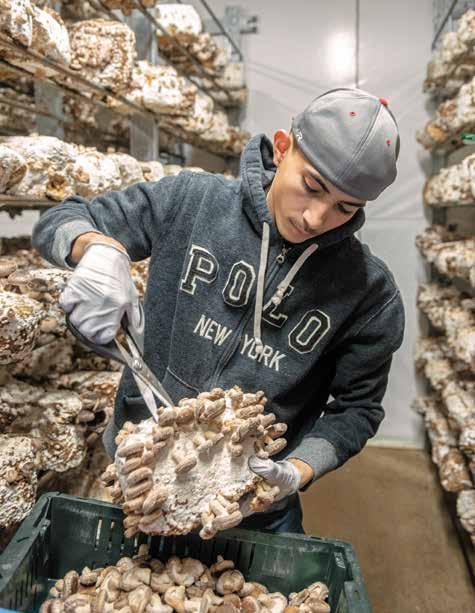
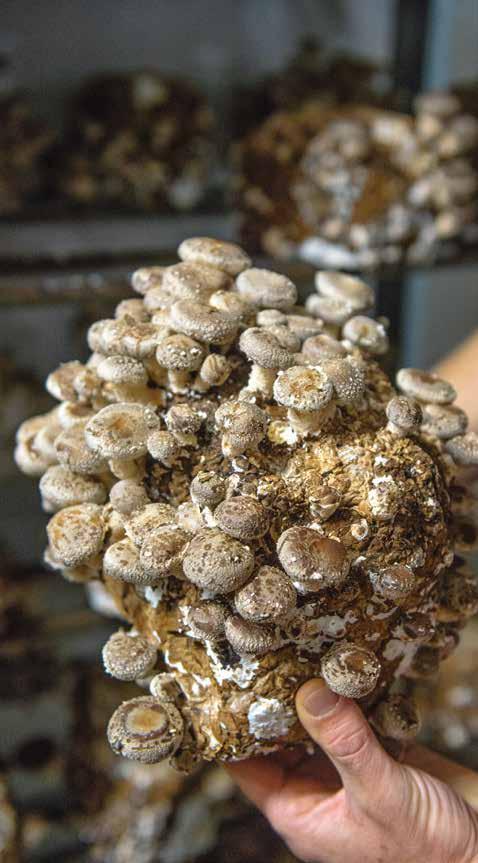
remarkably like a brewery. As the mushrooms grow, each variety develops its own unique scent. True to their name, oyster mushrooms smell a bit fishy, while Jared describes shiitakes simply as “pungent.”
Over a period of three to 13 weeks, depending on the mushroom variety, the mycelium reproduce, building up inside the bags that are lined up like soldiers on shelves. The bags start out in the earthy-scented shipping containers, then move to the high-humidity grow rooms in one of the farm’s larger buildings. The fungi grow inside the bags, sometimes until the bag bursts open. When they’re ready, the bags are plucked from the shelves and marched to the harvesting room. The mushrooms are carefully hand-cut off the top of the now-hardened block of sawdust, then weighed and loaded into boxes.
The process involves an almost dizzying amount of other intermediary steps, with scientific terms like inoculation, sterilization and colonization; it can take up to six months from the time Jared first touches the petri dish until the mushrooms are ready to eat. Yet with a staff of about 20 employees, Hazel Dell is able to produce and harvest 1,600 bags of mushrooms each weekday, yielding 3,000 to 5,000 pounds per week – that can easily add up to more than 250,000 pounds each year.
However, Jared and Lucinda don’t want to stop there; they’ve recently expanded their space and are poised to increase production from 1,600 bags to 2,500 bags per day by spring 2022. That will allow them to meet the demand for delivery to restaurants (the 5-pound mixed-variety box is the most popular), food distributors and natural-foods stores like Whole Foods, Vitamin Cottage and Sprouts.
Hazel Dell mushrooms are mainstays in dozens of Fort Collins and Boulder restaurants, and a few in Denver. Jared is especially grateful for longtime customers
Shiitakes are one of eight varieties cultivated at Hazel Dell Musrooms. While they are growing, shiitake mushrooms have a distinctly pungent aroma.
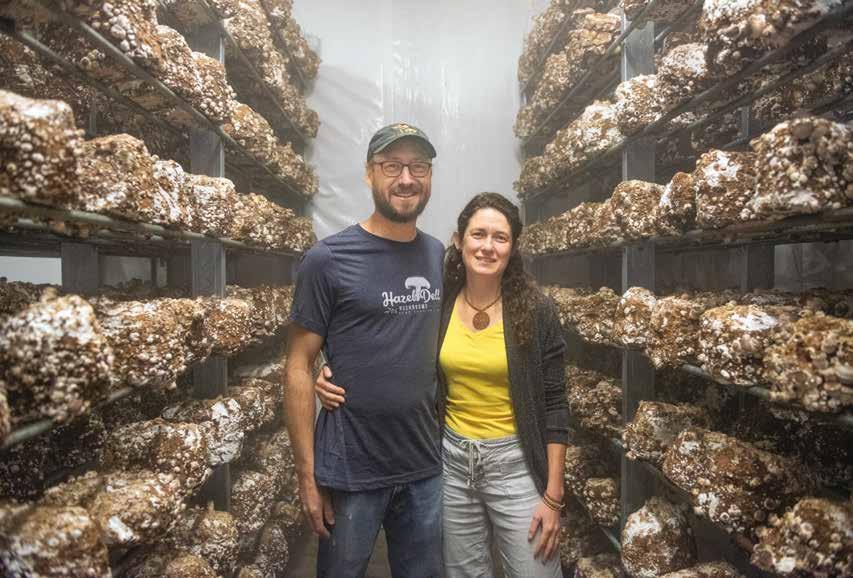
like The Regional in Fort Collins.
“They’ve always been focused on using locally sourced ingredients, and they’ve been ordering our mushrooms since they opened,” Jared said. “Their fried oyster mushroom sandwich is a customer favorite.” On the appetizer side, they also use Hazel Dell oyster mushrooms in their Truffle Mushroom Cheese & Pretzel.
“PEOPLE USED TO just wander around the farm, looking for someone to buy their mushrooms from,” Jared said. So he
and Lucinda remedied that by opening a small retail area at the front of the new production building. It’s where Lucinda can be found most weekdays, greeting visitors who stop by to purchase fresh or dried mushrooms for their culinary creations. If they need cooking inspiration, they can snag free recipe sheets, too.
Still fascinated with all things ’shroomy, and content with being a scientist-type farmer, Jared likes to experiment with cultivating additional mushroom varieties when he has the time. If those are success-
ful, they might become seasonal specials or maybe even get added to the permanent lineup that now stands at eight varieties.
“Jared’s always messing with something new,” Lucinda said. That’s because Jared knows the simple truth: “Mushrooms are having a moment.”
Hazel Dell may not be saving the world with earth-shattering, scientific fungi applications, but they’re making mushroom fans happy, and that might be close enough.
by KRYSTN POWERS
The ponds, creeks and reservoirs of Prowers County attract all manner of waterfowl annually. The most eagerly anticipated avian visitors are snow geese, as many as 200,000 of which arrive each year. The arctic birds stop over in southeast Colorado to feed and rest on their way to Texas and New Mexico, where they roost for the remainder of winter. Seeing so many geese in one place is a spectacle all its own, but the phrase “birds of a feather flock together” gains new meaning upon observing thousands of the birds lift off at once.
“It is a sight to behold in your lifetime … to see the sky completely covered in white snow geese flying,” High Plains Snow Goose Festival Director Jessica Medina said. “If you’re a birder, this is the place to be.”
The four-day festival includes seminars, guided sunrise tours and birding lessons. Attendees also get the opportunity to walk along the Willow Creek Trail or hike through Picture and Carrizo canyons and spot other animals and migrating birds. Experts from the Raptor Center at Pueblo’s Nature and Wildlife Discovery Center bring raptors to give attendees a chance to interact with the birds up close.
Photo contests are a prominent part of the festival. Participants submit photographs depicting local wildlife, natural landscapes, the area’s cultural heritage or a cross-section of the three. Attendees looking for more concrete souvenirs than photos can also expect a trade show/craft fair, where local artisans will have a variety of wares for sale. highplainssnowgoose.com.
Birdwatchers flock to Lamar each February to see the skies fill with as many as 200,000 snow geese.

The bed and breakfast is tucked in a residential neighborhood two blocks from Main Street. In addition to a complimentary hot breakfast, guests can relax outdoors on the turn-of-thecentury house’s ample front porch and back deck. Added upgrades can be arranged for couples celebrating their honeymoon or anniversary. 304 S. Third St. (719) 336-5217.
GRANADA RELOCATION CENTER NATIONAL HISTORIC LANDMARK
The Granada Relocation Center was one of 12 War Relocation Authority camps where Japanese Americans were forcibly interned during World War II. Renamed Amache to avoid confusion with the town of Granada, the camp housed thousands of internees from 1942 through 1945. Today, visitors can download a map and audio tour at amache.org and drive through the historic landmark. County Road 23 5/10, 2 miles west of Granada. (719) 734-5492.


Live music, craft beer and snowcapped mountains combine to make a quintessentially Colorado experience at WinterWonderGrass. Returning to the Rocky Mountains for its ninth year, the festival is a three-day celebration not just of bluegrass, roots music and local breweries, but also community and sustainability.
“We curate the experience to make sure people are exposed to a lot of different music in a fast and furious way,” WinterWonderGrass founder Scotty Stoughton said.
The festival grounds have one outdoor main stage and three heated-tent “beer halls” containing smaller stages. Three additional heated tents respectively house a VIP section, coffee bar and kids zone with face painting, hula hooping and crafts. Local food trucks are on hand. Festival goers should bring their own refillable water bottles, though, because single-use plastic bottles are not available for sale.
“We are really respectful and mindful of our delicate mountain communities,” Stoughton said. “I want to leave them better than we found them, whether it’s reducing trash, donating to non-profits or providing cultural value.”
Those interested in attending should purchase tickets before the event. Winter WonderGrass has a maximum capacity of 5,000 and typically sells out in advance. winterwondergrass.com.

Built in 1948, the hotel sits in the heart of historic downtown Steamboat Springs. Visitors can rent bikes at the Bristol to explore the town. In-hotel amenities include Mazzola’s Italian Restaurant, a hot tub and continental breakfast. Pet-friendly rooms are available. 917 Lincoln Ave. (970) 879-3083.

Breakfast is the specialty, but lunch options are available, too. Most breakfast dishes come with two farm fresh eggs – and the restaurant’s local agricultural partners mean many of the other ingredients are farm fresh, too. Dine-in and take-out menus are available. 131 11th St. (970) 879-4925.
Winter activities offered at Saddleback Ranch include snow tubing, snowmobiling and horseback rides, weather permitting. Indecisive visitors can even book sunset snowmobile tours and then go tubing afterward. Following a day of playing in the snow, visitors can warm with hot cocoa and concessions. Some activities are age restricted. 37350 County Road 179. (970) 879-3711.
A stunning mountain venue features roots music and craft beer at WinterWonderGrass in Steamboat Springs.
Jan. 13-16 • Aspen
Aspen locals spend four days each January paying tribute to the snowy season in a tradition that originated in 1951. Favorite traditions in years past have included concerts, a canine fashion show, mountain activities, bonfire and fireworks. Due to the ongoing pandemic, some activities may be presented differently than in years past, and additional precautions and protocols may also be in effect. (970) 925-1940.
Jan. 15-16 • Golden
Cowboy poets, Western singers and old-fashioned yodelers keep alive the spirit of the Old West. The performers’ poems and songs are full of cowboy wit and moving evocations of life on farms, ranches and the open range. The Saturday themed session and Sunday matinee are specially designed to be entertaining for kids and adults alike. (720) 213-6446.
Jan. 20-23 • Ouray
Beginning in November each year, ice farmers spray water down the Uncompahgre Gorge’s canyon walls to create an ice park complete with 100 manmade ice and mixed climbs, and 3 total miles of vertical terrain. Festival activities include competitions, vendor exhibitions, evening celebrations and more. Local guiding companies San Juan Mountain Guides, Peak Mountain Guides and Basecamp Ouray host ice climbing clinics. (970) 325-4288.

Cross-country ski races wind through the town of Crested Butte into the countryside beyond.
While throngs of costumed people are generally associated with Halloween, Crested Butte’s best costume party happens in February during the Alley Loop Nordic Marathon.
The Nordic marathon is, however, much more than a costume party. Racers on cross-country skis traverse streets, alleys and bridges through downtown Crested Butte, interacting with the event’s festive spectators. The revelry quiets down as the racecourse heads beyond the town into the surrounding countryside on the immaculately maintained Crested Butte Nordic trail network.
The changes of scenery along the course, from quaint Victorian alleyways

to exhilarating mountain vistas, make the Alley Loop “hands down some of the most phenomenal Nordic skiing you’ll find in Colorado,” Crested Butte Nordic’s Andrew Arell said.
Races include 42- and 21-kilometer classic ski contests, 42- and 21-kilometer skate contests, a 21-kilometer collegiate race, 10- and 5-kilometer contests and 3- and 1-kilometer youth races for participants 14 and younger.
For especially serious athletes, the Alley Loop is also a qualifying event for the American Birkebeiner, the nation’s largest cross-country ski race, which takes place three weeks later in Wisconsin. (970) 349-1707.


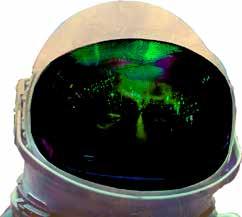


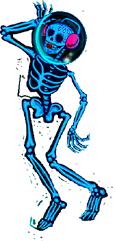







Once a saloon, this converted lodge can be rented by the room or in its entirety. There are five king suites; the sixth bedroom is a Chutes and Laddersinspired seven-bed bunk room. 512 Second St. (970) 349-7761.

Folk art and intricate woodblock prints adorn the walls of this Mexican restaurant, which specializes in enchiladas and tacos. Happy hour includes reducedprice margaritas and two-for-one tequila. 130 Elk Ave. (970) 349-5118.
Irwin Guides offers snowshoeing tours through aspen glades, mountain vistas and deep, dark forests. Half-day tours are $195 for the first person and $125 for each additional person in a group. 330 Belleview Ave. (970) 349-5430.
Jan. 21-23 • Pagosa Springs
This family-friendly weekend features sled races, fat bike races, the Hot Air Balloon Mass Ascension and the Penguin Plunge. The Pagosa Nordic Club also offers cross-country ski clinics and puts on the BB Gun Biathlon. In the popular skijoring competition, riders on horseback pull skiers and snowboarders through an obstacle course complete with ramps, gates and rings. (970) 264-2360.
Jan. 24-Feb. 2 • Breckenridge
Twelve snow-sculpting teams from around the world spend the first five days of the competition transforming 20-ton blocks of snow into massive yet detailed works of art. Sculptors are only allowed hand tools and their own imaginations –power tools are forbidden. The remaining seven days of festivities are for spectators to come view the fleeting outdoor art installation. (970) 453-2913.

Jan. 28-30 • Alamosa
The Rio Frio Ice Fest touts itself as a “beach party in the coldest place in the nation (sometimes).” Alamosa and the San Luis Valley experience some truly chilly winters, causing the Rio Grande, which normally flows through town, to freeze solid. The cornerstone event is the Rio Frio 5K footrace along the frozen Rio Grande River. Other highlights include a fat bike race, a reverse polar plunge and ice sculptures along Main Street. (719) 589-2105.
Feb. 12 • Estes Park
What is Valentine’s Day weekend without chocolate or wine? This 21-and-up event offers attendees sweet treats from regional chocolatiers and wine-taste pours from a variety of wineries with a Rocky Mountain National Park backdrop. Full price and designated driver tickets are available. (970) 586-6104.

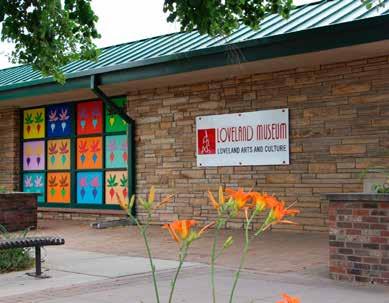
The Rialto Theater is located in Downtown Loveland Colorado and is host of many events, shows and performances through out the year. Visit rialtotheatercenter.org for details and tickets.
JANUARY 15, 2022 • 7:30PM

HILLBENDERS

Rialto Presents Season: Through March 2022 TICKETS ON SALE NOW
The Loveland Museum is an accredited art and history museum that is home to a variety of history exhibits, hosts world-class art exhibitions, and provides family events; adult and youth classes; lectures; poetry readings; and other programming opportunities. Visit THELOVELANDMUSEUM.ORG for more information.


The stock show kicks off with a Western parade through the streets of downtown Denver.
One of the nation’s largest and longest-running livestock events makes its highly anticipated return to Denver with 16 days of rodeos, horse shows, and celebrations of agriculture and Western heritage.
The National Western Stock Show, a Denver tradition dating back to 1906, hadn’t missed a year in more than a century until circumstances forced organizers to cancel last year’s event. When the stock show makes its dramatic comeback this year, longtime attendees will find the same event they know and love – but with major upgrades to its facilities.
The newly built Cille and Ron Williams Yards stretch across 20 acres, providing enough space for 25 breeds of cattle, bi-



son and more. “These new yards provide the foundation for ranchers and cattle producers across the world to embark on Denver for the ‘Super Bowl’ of livestock shows,” National Western Stock Show President and CEO Paul Andrews said.
Also making its debut is the 46,000-square-foot H.W. Hutchison Family Stockyards Event Center, the new centerpiece of the historic site, featuring state-of-the-art auction and show arenas.
“Wear your comfortable boots,” Andrews said, “because there is a lot of ground to cover and animals to see.”
The stock show is packed with events, with rodeos figuring prominently. Opening day boasts three Colorado vs. the



World rodeos, in which rodeo champions from Colorado face off against rodeo champions from everywhere else.
Other rodeos include the Mexican Rodeo Extravaganza, PBR Bull Riding and MLK Jr. African American Heritage Rodeo. Youngsters age 5-7 and weighing less than 55 pounds can get in on the fun by riding sheep in the Mutton Bustin’ event.
Part of the stock show’s appeal is that it is equally enjoyable for livestock professionals and city folk alike. Family-friendly events abound. The NWSS Wild West Shows take audiences on a trip back in time with re-enactments of the original Buffalo Bill’s Wild West shows.
At the Xtreme Dogs Show, highly trained canines perform amazing tricks and aerial stunts. The stars of the show meet their fans for a “pat and chat” after each performance. Other events have dogs showing off their stock herding skills or trying to pull a weighted cart 16 feet in one minute.
With pony rides, a free petting farm and more, the stock show truly does have something for all ages. (303) 296-6977.
Located just a short walk down Brighton Boulevard from the Stock Show, this world-class collection of rare automobiles and trains includes one of the largest steam engines ever built. 4303 Brighton Blvd. (303) 297-1113.

Ten blocks more blocks down the street is this new, nine-story hotel. It is attached to a historic building that houses two market halls with 25 unique restaurants and retail shops. 3330 Brighton Blvd. (720) 409-1200.

Among the artisanal restaurants at the Source market hall is this Chicagoinspired spot that serves thin crust, tavern-style pizza, baked in a rotating oven and sliced into squares. 3350 Brighton Blvd. (720) 207-9615.

Feb. 12 • Lake City
The Brew-Ski consists of a Saturday late morning and early afternoon spent on Lake San Cristobal, where participants choose to walk, ski, sled, snowshoe or dog sled from station to station on a 1-mile-long course. At each of the six stops along the course, attendees are greeted with delicious baked goods and beers from hometown favorite Lake City Brewing Co. (970) 944-2527.
Feb. 18-22 • Silverthorne
Located against dramatic vistas of the Gore Range, North Pond Park is the home of this outdoor hockey tournament. Competition begins with a four-game round robin, with winning teams advancing through a bracket-style playoff. In addition to on-ice athletic competition, there’s a fashion competition during the Apres Ice Party, when a cash prize is awarded to the player with the best hockey hair. (855) 732-3771.


LAUNCHING POINTS FOR OUTDOOR EXPLORATION

by DAN LEETH
Skyrocketing popularity of Colorado campgrounds makes advance reservations a must
WHEN I FIRST started camping, I’d simply load a tent, sleeping bag, food and Coleman stove into the trunk of my car and head off into the hills. Sometimes I had a site in mind, but most of the time, it was totally serendipitous. When I found a campground to my liking, I’d pull in, choose a site and set up camp. Campsites were all first come, first served, and there was seldom a shortage of spots available.
Those days are largely gone. Colorado’s population has jumped nearly 40 percent over the last two decades, with many lured here by the opportunities for outdoor recreation. Eager to head for the hills, those new Colorado residents soon succumb to the old adage, “We love our town so much, we leave it every chance we get.”
Adding to the camping onslaught are members of the baby-boom generation. Recently retired, many long to re-experience the outdoors as they did back when they were clad in waffle-stompers and humming “Rocky Mountain High.” Back then, camping usually meant sleeping in a leaky tent and eating canned beans warmed on that Coleman stove. Campers today have the option of comfortably bunking down
in shelters ranging from tiny tent trailers to bus-size motorhomes, all with microwave ovens to warm those beans.
Then along came this pesky pandemic. When folks could not take cruises, they turned to camping. According to the RV Industry Association, the number of new recreational vehicles hitting the road last year exceeded the previous year’s figure by 33.8 percent. More than 45 million Americans planned to take an RV trip from mid-2020 to mid-2021. Not all of them came to Colorado, although camping in our state park campgrounds was up nearly 25 percent in 2020.
BLM sites. That can mean booking a summer marshmallow-roasting-over-a-campfire trip in the depths of winter.
To find a summer campsite, start your search in winter.
Making a camping reservation is relatively easy. Most national park and monument sites, as well as many national forest or BLM sites, are reserved through the site recreation.gov (877-444-6777). An exception is Mesa Verde National Park, which is reserved through visitmesaverde.com (800-449-2288). State parks can be reserved through cpwshop.com (800-244-5613).
be charged for some destinations.
One of the bad things about advance reservations is that sometimes situations change. Most federal sites allow cancelations up to two days in advance and will refund the camping payment, minus a $10 cancellation fee. Colorado state parks require cancellation two weeks in advance for a full refund, minus a $6 cancellation fee. Those who simply fail to show up may be charged a no-show fee of up to $20, so be sure to cancel unwanted reservations so others can use the site.
In addition to our own residents, Colorado campgrounds attract a multitude of out-of-state campers. Travel website tripsavvy.com ranks Colorado the No. 1 state for camping.
With all the competition for campsites, it’s become increasingly necessary to reserve sites up to six months in advance, especially for those of us wanting to camp in popular places like national and state parks, as well as premium national forest and
Both the federal and state online sites allow you to key in desired dates, generally up to six months in advance. You then choose the type of site you are looking for (tent, trailer or motor home) and for RVs, the length of your rig and what amenities (electricity, water, sewer, pull-through driveway) you desire. A map of the campground shows the location of sites that match those parameters. Click on the site icon and more information pops up, sometimes showing a photo. Select your favorite and then pay by credit or debit card for the days desired. An additional reservation fee of up to $10 may
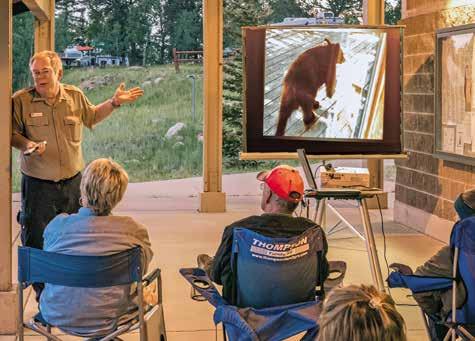
Even though reservations are best made months in advance, sometimes one just gets lucky. Last summer, my wife and I had some unexpected time to spare and the desire to head to the mountains for a few days. We could have looked for a firstcome, first-served site somewhere, but in our experience, open sites are seldom seen after mid-morning. Instead, I opened the laptop and started searching for reservable campgrounds a reasonable distance from home. The state parks were booked solid, but I found a single Forest Service campsite available for the dates we needed. Some thoughtful camper had canceled, and we became the beneficiaries.
HARVEY
ICE CRYSTALS CLING like rock candy to a wire fence north of Durango as Cheryl Albrecht-Harvey cross-country skis in the Animas River Valley. Though the temperature is well below freezing this morning, there isn’t a cloud in the sky.
Photographer Kennan Harvey chose this day to take a picture of his wife skiing because he knew weather conditions were just right for producing the kind of ice formations he loves to photograph. When morning fog forms in the valley, the preceding night has been clear and dry, and the temperature is around zero, Harvey said, “those are prime crystal-growing conditions.”
Harvey photographed the scene using an f-stop of f/14. “I wanted the crystals in the foreground to be sharp, but I also wanted my wife in the background to be mostly in focus,” he said. “You need a bigger depth of field to capture that.”
IN EACH ISSUE, “Top Take” features a reader’s photograph of Colorado. Submit your best photos for the chance to be published in Colorado Life. Send images with detailed photo descriptions and your contact information to photos@coloradolifemag. com or visit coloradolifemag.com/contribute.
This photo was taken with a Nikon D300 camera equipped with a Nikkor 12-24mm f/4 lens at 12mm, exposed at ISO 100, f/14 at 1/320 of a second.

